
NOBUKO TODA ’03 AND KAZUMA JINNOUCHI ’02 ARE TOP SCORERS IN A BOOMING INDUSTRY



NOBUKO TODA ’03 AND KAZUMA JINNOUCHI ’02 ARE TOP SCORERS IN A BOOMING INDUSTRY

Metal Gear Solid and Halo composers
Nobuko Toda ’03 and Kazuma Jinnouchi ’02 talk about the paths to their careers and what it takes to level up in the video-game industry.
BY KIMBERLY ASHTON
The Mayan people of Mexico’s Yucatán Peninsula breathe new life into their ancient heritage, with help from a Berklee alum. BY
KIMBERLY ASHTON
Known for its rigor, Kuala Lumpur’s International College of Music has set up hundreds of students for success at Berklee over the past 25 years. BY REBECCA BEYER 32 KEY CHANGES
Its Rhythm
As evidence of music therapy’s benefits grows, the practice is increasingly showing up in hospitals, schools, and more. BY SUSAN GEDUTIS LINDSAY
Faculty Notes 43
INTERVALS Protecting Your Rights in the Digital Age 45 BY ALLEN BARGFREDE
‘Just Play’: The African-Infused Method Helps Students Learn Music Through Movement 47 BY KEVIN HARRIS
FACULTY PROFILE
George Howard 49 BY MICHAEL BLANDING
NEWS FROM OUR ALUMNI COMMUNITY
Alum Notes 54
ALUMNI PROFILES
Dayramir González 55 BY NICK BALKIN
Dan Radin 57 BY JED GOTTLIEB
Kelly Buchanan 59 BY BRYAN PARYS
Final Cadence 62
Securing the Future of Music in Spanish BY JAVIER LIMÓN

On the cover: TK photographed by James Day. Opposite: Guido Tktktk photographed by Evangeline Gala

EDITORIAL DEPARTMENT
DIRECTOR
SENIOR COMMUNICATIONS MANAGER
COMMUNICATIONS MANAGER
PROOFING MANAGER
Berklee Today | Fall/Winter 2022 A PUBLICATION OF THE OFFICE OF EXTERNAL AFFAIRS
EDITORIAL DIRECTOR
CONTRIBUTING WRITERS
DESIGN
COPY EDITORS
CONTRIBUTING ARTISTS
Kimberly Ashton
Nick Balkin, Allen Bargfrede, Rebecca Beyer, Michael Blanding, Tori Donahue, Jed Gottlieb, Kevin Harris, Javier Limón, Susan Gedutis Lindsay, John Mirisola, Bryan Parys, Mark Small, Beverly Tryon
Patrick Mitchell, André Mora MODUSOP.NET
Diane Owens Lauren Horwitz
Kelly Davidson, James Day, Evangeline Gala, John Huet, Oriol Vidal, Mark Weaver
Nick Balkin
Bryan Parys
John Mirisola
Lesley O’Connell
OFFICE OF INSTITUTIONAL ADVANCEMENT
SENIOR VICE PRESIDENT OF INSTITUTIONAL ADVANCEMENT
INTERIM SENIOR DIRECTOR, BERKLEE ALUMNI AFFAIRS
ASSOCIATE DIRECTOR OF ALUMNI AFFAIRS/LOS ANGELES
ASSISTANT VICE PRESIDENT FOR INSTITUTIONAL ADVANCEMENT
SENIOR MANGING DIRECTOR, INSTITUTIONAL ADVANCEMENT SPECIAL PROJECTS
Erin Tunnicliffe
Joseph Dreeszen
Dana M. James B.M. ’09
Beverly Tryon ’82
Virginia Fordham B.M. ’80
As the alumni-oriented magazine of Berklee College of Music, Berklee Today is dedicated to informing, enriching, and serving the extended Berklee community. By sharing information about college matters, music industry issues and events, alumni activities and accomplishments, and musical topics of interest, Berklee Today serves as a valuable forum for our family throughout the world and a source of commentary on contemporary music. Berklee Today (ISSN 1052-3839) is published twice a year by Berklee College of Music’s Office of External Affairs. All contents © 2022 by Berklee College of Music.
Send all address changes, press releases, letters to the editor, and advertising inquiries to Berklee Today, Berklee College of Music, 1140 Boylston St., Boston, MA 02215-3693, +1 617-747-2843, kashton@berklee.edu. Alumni are invited to send in details of activities suitable for coverage. Unsolicited submissions are accepted. Alum Notes may be submitted to berklee.edu/alumni/forms/alumni-updates. Visit us at berklee.edu/berklee-today.

in its latest Global Music Report, the trade group IFPI says that the international music industry grew more than 18 percent last year, bringing in almost $26 billion. The Motion Picture Association, the group representing the movies, says its industry grossed nearly $100 billion, about the same as it did before the pandemic.
As large as these figures may seem, they are dwarfed by what the video game industry raked in last year: $193 billion worldwide, according to the Gaming Industry Survey report by Ernst & Young Global Limited (EY).
“It’s breathtaking to witness the pace with which the video game industry is evolving, especially with all the new forms of extended reality,” says Esin Aydingoz, the assistant chair of Berklee’s Screen Scoring Department, formerly known as the Film Scoring Department.
In fact, the department created a new major—game and interactive media scoring—in response to this changing media landscape, says Sean McMahon, the department’s chair. “By all indications, video games are the future of media. The video game industry continues to expand rapidly, all over the world, and it’s having a huge influence on the movie and music industries.”
And the pace of growth is likely to pick up as virtual-reality technology advances. Game scorer Nobuko Toda ’03, featured on this issue’s cover along with her professional partner Kazuma Jinnouchi ’02, says that she is seeing the technology open up more and more audio possibilities for these 3D environments, and the industry is following (p. 12).
I caught up with the pair, over Zoom, while they were in Tokyo, just before leaving for London to score their next big project at Abbey Road Studios. In addition to talking about industry trends, we discussed their music backgrounds, how to score a franchise game, and advice they’d give to aspiring video game composers.
Also in these pages, I visit Guido Arcella M.M. ’15—who graduated from Berklee Valencia’s scoring for film, television, and video games program— to talk about the nonprofits he cofounded that help young Mayan people in Mexico’s Yucatán Peninsula hold on to their heritage through music.
This issue also examines the remarkable changes in the music therapy business over the past 10 years; pays tribute to Vice President for Academic Affairs/Vice Provost Jay Kennedy, who is retiring after 28 years at the college; takes a look at Berklee’s partner school in Malaysia; and more. I hope you enjoy these stories as I have.
STUDENT CHARLEY TIERNAN, WHO PERFORMS AS CHARLEY, SINGS AT THE INSTITUTE OF CONTEMPORARY ART ON AUGUST 25 AS PART OF BERKLEE’S SUMMER IN THE CITY CONCERT SERIES.
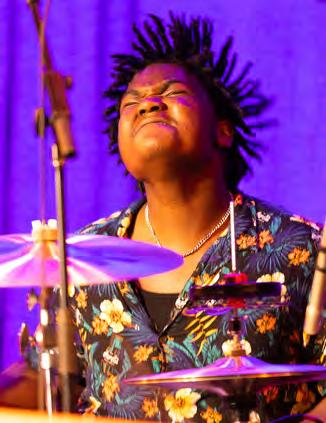
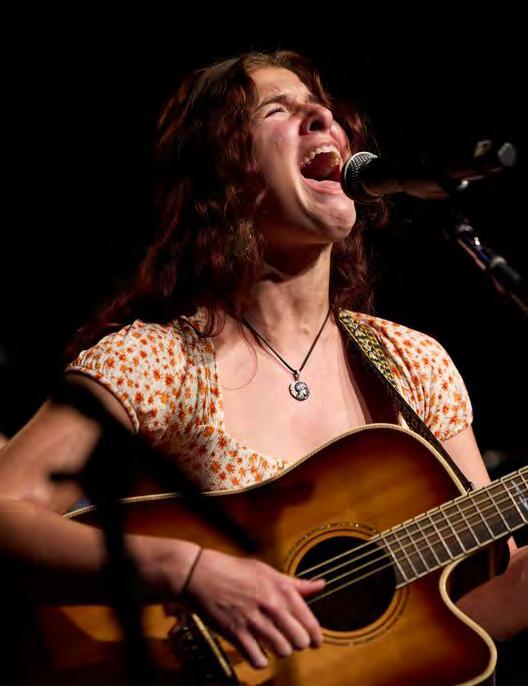


BY TORI DONAHUE AND KIMBERLY ASHTON

In the spring of 2012, Berklee launched its first global studies program in Valencia, Spain, at the vibrant City of Arts and Sciences. Now known as Berklee Study Abroad, this program opened the doors to Boston undergraduates seeking to expand their horizons by spending a semester away from the main campus, and it marked the inception of Berklee’s Valencia campus.
That fall, master’s degree students came to Valencia for the college’s first graduate programs: global entertainment and music business; contemporary studio performance (later named contemporary performance [production concentration]); and scoring for film, television, and
video games. In the fall of 2013, the music technology innovation program, known now as music, production, technology, and innovation, was added.
Following the merger of the college and Boston Conservatory, Berklee Valencia launched its first opera program, the Boston Conservatory Opera Intensive at Valencia, during the summer of 2017. And in the fall of that year, Berklee began a program that allowed firstyear students the opportunity to begin their experience in Valencia.
Now in its 10th year, Berklee Valencia has welcomed more than 4,000 students from 85 countries and has awarded over $10 million in scholarships.
The past decade was only the beginning. In 2020,
Berklee and the government of Valencia signed a renovation agreement that allows the campus to stay in the City of Arts and Sciences for an additional 40 years. “Knowing that we have a secure home in Valencia for the coming decades, in a space as incredible as the City of Arts and Sciences, lends stability to our campus and allows us to start building new programs and initiatives,” says Simone Pilon, Berklee Valencia’s dean of academic affairs.
The agreement includes a provision in which Valencian students who have been admitted to one of the master’s degree programs are eligible to receive a scholarship to attend Berklee Valencia.
It also allows Berklee to expand its footprint in the
City of Arts and Sciences by 25 percent. María Martínez Iturriaga, the executive director of Berklee Valencia, says the increase in space will allow for the addition of study and meeting rooms for students; a small stage for open mics; a 100-person event and performance room; a music production suite; two large classrooms; a larger DJ lab; and more. Berklee aims to start renovations this spring and plans to have them completed by spring 2025.
“Berklee Valencia has great potential in terms of leveraging its geographic presence in Europe and the Mediterranean,” Martínez Iturriaga says. “We aspire to serve as a bridge between these cultures and the rest of the world, as well as continuing being a catalyst for innovation and creativity.”
BY BEVERLY TRYON
On October 1, guests gathered at Boston’s Westin Copley Place for the 28th Berklee Encore Gala benefitting Berklee City Music.
Following a cocktail reception, they were treated to bluegrass, jazz, rock, and world music performances by student, faculty, and alumni musicians, who played both during the dinner and afterward in nightclub settings. Musical acts included the Berklee Indian Ensemble, Eguie Castrillo Salsa Orchestra, Radius, Studio Two, the Berklee City Music Ensemble, Nebulous, and Soil 4 Soul.
The event also featured special guest artists MOLLY TUTTLE and Golden Highway. Tuttle '14 is the first female artist to win the International Bluegrass Association’s Guitar Player of the Year award. The night ended on a high note with a dance party featuring
the Family Stone singing hits such as “Dance to the Music” and “Everyday People.”
As part of a live auction experience, guests bid on a private dinner package with Red Sox legend and recent Baseball Hall of Fame inductee David Ortiz, along with VIP tickets to see CHARLIE PUTH B.M. ’13 perform in Boston.
The event raised $1.4 million to provide critical scholarship assistance to deserving young students. For 29 years, City Music has enabled young musicians marginalized by socioeconomic barriers to fulfill their artistic, academic, and personal potential through the study of music. City Music reaches hundreds of thousands of young people through City Music Boston and 46 partner organizations in 40 cities across the U.S., Canada, and Latin America.
Special Thanks to Our Encore Gala Sponsors
Copresenting Sponsors
Abrams Capital
Bain Capital Community Partnership
Colead Sponsors
Aramark Education
Boston Celtics Shamrock Foundation
Bill and Kelly Kaiser
Martin and Tristin Mannion
Main Ballroom Sponsors
Sandhya S. and Craig S. Douglas
Lynch & Associates
Miky Lee
New Balance Foundation
PEPSICO
Gregory Annenberg Weingarten, GRoW@Annenberg
Andrew and Mariann Youniss

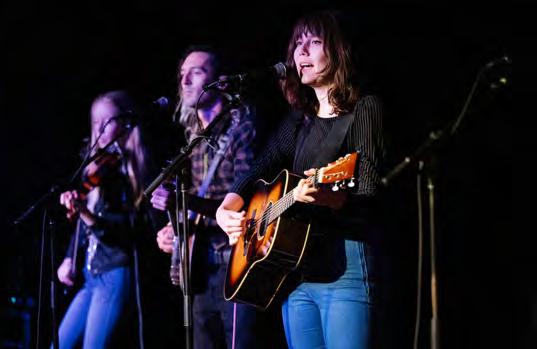

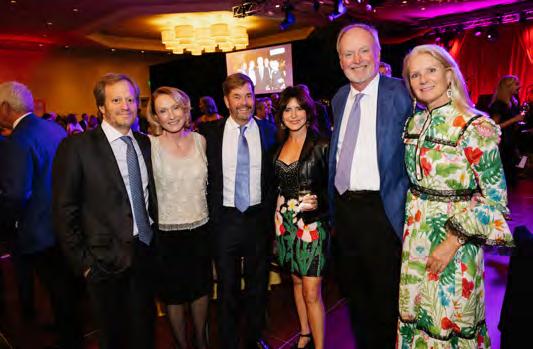
Event Cochairs
Sandhya S. and Craig S. Douglas
Bill and Kelly Kaiser
Performance
EVENT: 2022 Commencement Concert
DATE: Friday, May 6, 2022
LOCATION: Agganis Arena, Boston
DETAILS: Spoken-word artist Ljuliana Giselle Thomas, from Memphis, Tennessee, performs Stevie Wonder’s “Jesus Children.”




BY JOHN MIRISOLA
The road to the Berklee Indian Ensemble’s first album, Shuruaat (Hindi for “beginning”), might have seemed improbable. What began as a small academic ensemble over 10 years ago has evolved into a YouTube phenomenon with close to 300 million views and an international music distribution deal. But hearing how skillfully the ensemble flows through styles, balancing immense talent with serious fun, it’s no surprise that the group managed to arrive at this new achievement.
“The main thing that has always driven us are two questions: what if? and why not?” the ensemble’s leader, Berklee India Exchange Artistic Direc-
tor Annette Philip, says. “Just because it might be hard is not a good enough reason to not do this, or not even try.”
Featuring 98 musicians from 39 countries, and collaborations with legends including ZAKIR HUSSAIN ’19H, Shankar Mahadevan, Vijay Prakash, and Shreya Ghoshal, Shuruaat assembles 10 of the group’s most memorable performances into a cohesive musical journey. “It really is a full spectrum of what the ensemble has created as a team, as a family, over the last 10 years,” says Philip.
Out this summer, the album also marks a milestone in ethical music business practices. “We have set up Berklee’s first—and probably one of the
world’s first—equitable, just revenue-sharing systems,” Philip explains, adding that everyone who is part of the album receives a prorated revenue share for life. “We want our students and our alumni to know that they have rights, and they have to be treated correctly, no matter who their collaborator is.”
Ultimately, these thoughtful business practices are of a piece with the overarching messages of positivity and unity at the core of Shuruaat. “The music we create is first and foremost to share joy,” says Philip. “We want to remind people...that there is so much good in the world and so many well-meaning people in the world.”


It’s Joni’s World, We’re Just Living In It
Berklee awarded Joni Mitchell an honorary doctorate on August 23 in recognition of her incalculable contribution to music. Known for her complex harmonies and soul-baring lyrics, Mitchell helped shape the sound of not just her own generation but of those to come.

“Well, luckily I’m too old to get a swelled head,” Mitchell said of receiving the honor. “It’s a beautiful event. Words can’t describe it. I’ve got my good friends here with me,” she added. WAYNE SHORTER ’99 and HERBIE HANCOCK ’86H sat next to her during the private ceremony in Los Angeles.
Throughout her six-decade career, Mitchell has turned out a long list of achievements. Last year, she was given a Kennedy Center Honor for her contribution to American culture; this year, the MusiCares Foundation named her its Person of the Year. She’s won four Juno Awards and nine Grammys (and has been nominated for seven others). In 2002, the Recording Academy gave her its Lifetime Achievement Award.
KIMBERLY ASHTON
BY KIMBERLY ASHTON
NOTE: THIS STORY CONTAINS SPOILERS.
After HBO’s blockbuster success Game of Thrones aired its final episode in 2019, the network looked into several spinoff ideas before landing on what would become the franchise’s follow-up, House of the Dragon. The show, a prequel, had to assert its own identity while also maintaining a continuity to the original series. Part of what kept the link strong between the two shows was the decision to have RAMIN DJAWADI B.M. ’98, who scored Game of Thrones (GOT) and composed its famous theme song, write the music for House of the Dragon (HotD). Below, Djawadi talks about how he created a musical world unique to HotD while staying true to the
broader GOT soundscape.
House of the Dragon kept the original Game of Thrones theme song for its opening sequence. Could you talk a bit about the decision to do this rather than to give House of the Dragon its own theme?
The original GOT theme was created as an overarching theme for the entire show, a theme that represents the journey of all the characters and plots of the vast story that George R.R. Martin has created. We wanted to connect HotD to the original series with the same main theme.
House of the Dragon is set 200 years before Game of Thrones. How did you reflect this in your music?

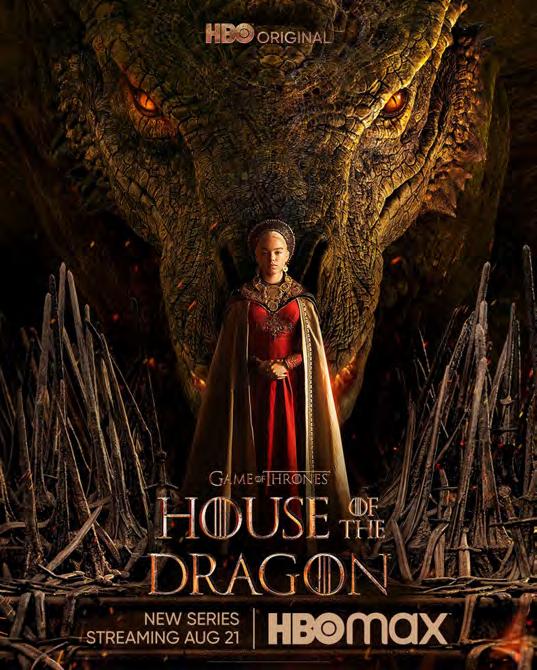
We wanted to connect the music to the original series by having familiar sounds and themes, but the majority of the material is new. The cello is still the primary instrument and there are familiar themes like the king’s theme or the dragon/Targaryen theme, but most of the themes are new. We needed to create new themes for all the different new houses and also have dedicated themes within the Targaryen family for Rhaenyra, Daemon, etc. There are some sonic differences in the HotD score that do not exist in the original GOT score. When woodwinds or solo vocals are used, it is with the intent that certain instruments can be heard in HotD, but are then less common [or] not used anymore 200 years later.
In Game of Thrones, you used certain instruments for various characters or storylines. Do you have any instruments you favor for House of the Dragon characters?
We certainly continued that approach. The Velaryons have bamboo flutes and percussion that distinguishes them as world travelers. The Targaryens have
the same sonic sound that we know from GOT, but new additional themes. The silent sisters have a choral texture, etc.
Are there any (other) specific allusions to GOT embedded in the music for House of the Dragon?
The main title theme gets hinted at quite a few times in more abstract ways when Viserys talks about his dream. [It’s] a nice opportunity to connect to GOT and foreshadow what’s to come with viewers that are familiar with the original show.
What’s been your favorite scene to write music for so far in House of the Dragon? What’s been the most challenging scene to score?
There are many beautiful scenes I could mention from each episode. The final scene in [the first episode], which made us decide to use piano right away. Daemon’s surrender in [the third episode]. Alicent’s entry during the wedding in [the fifth episode]. The funeral scenes are challenging; they are so emotional.
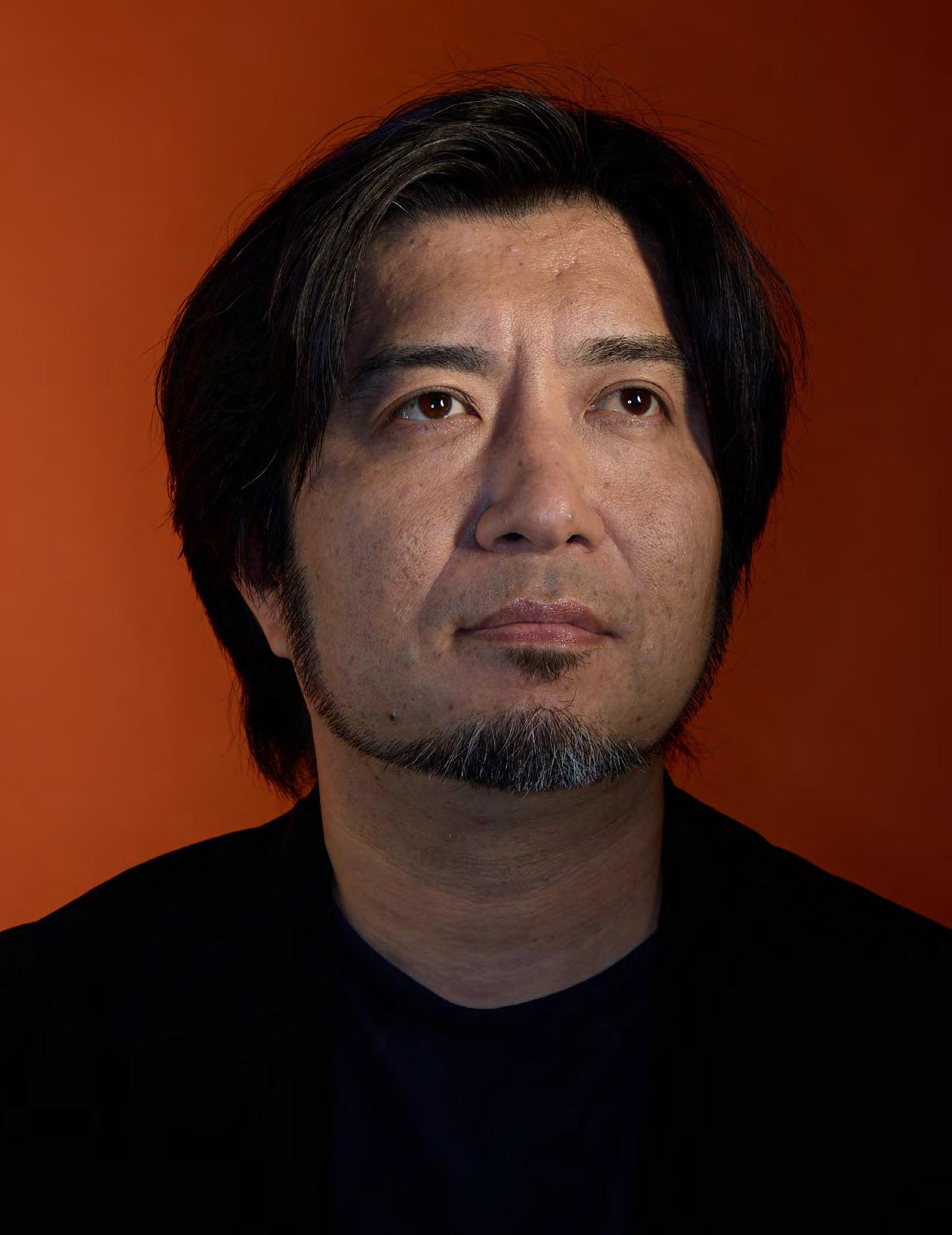
STORY BY Kimberly Ashton

METAL GEAR SOLID AND HALO COMPOSERS NOBUKO TODA ’03 AND KAZUMA JINNOUCHI ’02 TALK ABOUT THE PATHS TO THEIR CAREERS AND WHAT IT TAKES TO LEVEL UP IN THE VIDEO GAME INDUSTRY. it looked really cool…I made the request again: “Hey, if it’s flute can I go take lessons?” and then they said yes.
In 2006, NOBUKO TODA ’03 was working on the music for the fourth installment of the blockbuster video game franchise Metal Gear Solid when she called her former classmate Kazuma Jinnouchi to ask him to help her score the project.
KAZUMA JINNOUCHI ’02, who at the time was an arranger and indie pop-rock guitarist gigging around Tokyo, hadn’t done any professional work as a film scorer. Moreover, years prior, as a new student at Berklee, he had dropped any nascent idea he had harbored of pursuing film scoring after feeling overwhelmed by an introductory class. Sure he wasn’t up to the task, Jinnouchi declined Toda’s offer.
But Toda knew what Jinnouchi could bring to the project. As students, the two often found themselves in the same classes and would listen to each other’s music and give feedback. After graduation, they stayed in touch and would occasionally work together.
music programmer on Halo 4, and brought in Toda, who was a freelancer, as an orchestrator and score producer.
For the next release in the franchise, Halo 5: Guardians, Jinnouchi was the composer, and Toda was the game’s orchestrator and executive music producer. That game was the biggest Halo launch at the time, bringing in over $400 million in sales in its first week. (For comparison, the highest-grossing movie in history, 2009’s Avatar, had an opening week of $137 million.)

In addition to knowing the quality of Jinnouchi’s musical ideas, Toda knew that he was capable of working long hours in a demanding production environment, which is just what she needed in a collaborator on Metal Gear Solid 4: Guns of the Patriots.
“All the orchestral things I could just teach him afterward,” Toda said during a recent interview from Tokyo.
Swayed by his friend’s insistence, Jinnouchi went through the demo process at Konami Digital Entertainment, makers of Metal Gear Solid, and got the job. The only thing left to do was to learn how to score a game. “All these scoring things were so new to me, so Nobuko pretty much taught me how to write to the visual,” Jinnouchi said.
The game was a hit, and the two continued to work together for the next five years as in-house composers at Konami subsidiary Kojima Productions. In 2011, Jinnouchi left the company to join the team making the latest Halo game, one of the industry’s most famous franchises, at Microsoft’s 343 Industries. A member of the in-house audio team, Jinnouchi served as an additional composer, music editor, music director, and
Jinnouchi left Microsoft in 2018. Today, he and Toda work as freelancers, and have collaborated on Marvel’s Iron Man VR and many animated series, such as Ultraman, Ghost in the Shell SAC_2045, and Star Wars: Visions . They’re currently working on a Japanese animated film as well as a major superhero franchise video game, due out in 2024. During a busy August that found one or both of them in Tokyo, London, Prague, Kuala Lumpur, or Seattle, Toda and Jinnouchi dialed into a video call to talk about their music backgrounds, scoring a franchise game, trends in video game music, advice they’d give to aspiring video game composers, what they listen to when they drive, and more. Jinnouchi, who’s lived in Seattle for 11 years, provided some translation for Toda, who’s been primarily based in Tokyo. The interview has been edited for length and clarity.
Tell me about your early experiences with music. How old were you when you began playing instruments?
KAZUMA JINNOUCHI: This goes back to elementary school, but I originally wanted to start taking piano lessons just because I was fascinated by the instrument by watching my teacher play. I was really small at the time…so my parents didn’t know if I would continue to be interested in that kind of musical instrument, so that request got rejected. Later, when I was in the third grade, I was looking at this picture of the flute. I think it was in the newspaper. And I thought
NOBUKO TODA: I grew up in a very poor family. My father reduced his own allowance so that I could learn to play the piano and organ. When I started attending classes, my father picked up a small foot-pedal organ from somewhere and I played it every day. I had an electronic organ and the piano. I don’t exactly remember how I started playing those instruments, but my mother told me that when I was very young I pointed out a picture of an electric organ in the newspaper and said I wanted to play it. I started playing for fun. I also would read picture books and then write original music to the book. I really liked to make storybooks too. For quite a while I was self-taught on the instrument. The same for composition, for writing music. But when I wanted to enter a competition for electric organ performance, the requirement was also to perform my own music so I was writing for that every year.
How old were you then?
NT: From middle school to high school, so from around 11 or 12 to 16 or 17. My dream was to be a performer who toured abroad.
Kazuma, what was your involvement in music at that age?
KJ: I was continuing to take my flute lessons throughout the rest of my elementary school and middle school years, and then I started getting into coding, [into] programming things, because all my friends were playing video games on the Nintendo system and I had asked my dad if he would get me a Nintendo system for Christmas, and the answer was no.
But he was interested in computers and bought a computer, and showed me how to program things. He told me, “Hey, if you want to play a game, you can make your own.” I wasn’t very good at it but it was a lot of fun. At a certain point, I was comparing my program, which somewhat looked like a video game, to the Nintendo games… and one thing that came to my mind was, “Oh, my game doesn’t have any music in it. I need to start composing music.” So I

“NOBUKO AND I WERE BOTH FORTUNATE ENOUGH TO GO THROUGH BIG STUDIOS THAT RELEASE GAMES WORLDWIDE, AND [FOR WHICH] THERE HAS TO BE ACHIEVED A CERTAIN LEVEL OF SUCCESS. THERE’S AN EXPECTATION OF THE QUALITY THAT WE NEED TO HIT,” SAYS KAZUMA JINNOUCHI.
INSET, OPPOSITE: TODA AND JINNOUCHI AT WORK AT ANGEL STUDIOS IN LONDON.



got the sound module, like one of the early hardware midi modules in the mid-’90s. I installed the sequencer on my pc and then started playing notes. But I couldn’t play keyboard at the time, so I was playing flute and then coming up with a melody and just entering notes one by one.
I started thinking, “Oh, I need to learn how to write harmony.” I was already 16 years old, and I knew it was pretty late to start playing piano…but a lot of friends were starting to play guitar. I thought, “Oh, if they’re starting to play an instrument now maybe I can catch up.” So I got my acoustic guitar, and the way I composed was playing a flute and coming up with a melody, and then playing guitar on top of it to come up with a chord, and I was just sequencing those one note at a time.
Did you want to major in film scoring when you entered Berklee?
KJ: So initially I wanted to go for a film scoring major because when I was in high school [during a year abroad] in the U.S., one of the classes I took was a music tech class. My teacher gave me a Three Stooges [clip]. We had to write music for it. It was a lot of fun doing it.
But when I first took the intro to film scoring class [at Berklee], I sort of realized that the major was built for someone who can already write music, and I was still struggling to write a proper harmony. I thought that was way too advanced for me.
My father told me, before going to Berklee, that I can go to whatever school [I want] but that should be the only school [I go to] because [my parents] won’t support me financially beyond that. So I was thinking in a very practical manner: “Okay, if I go out in the professional world I probably want to be in a studio environment and do the writing. And I need to be able to write in lots of different instrumentation”…so I decided that the contemporary writing and production [major] matched my requirements pretty well.
[Also,] after the first day at Berklee, going through auditions and getting shocked by all these talented students, my mind when I chose the major was, “Okay, if I can make a living in this world, I’m okay with really anything.”
Nobuko, what was your plan when you entered Berklee?
NT: I had applied for a scholarship at Berklee and was asked to go through an interview. I came to Boston for that, and at the hotel where I was staying there was a group of Japanese people who came to see a JOHN WILLIAMS ’80H concert. I got to know this Japanese group and went to the John Williams concert all three days that John Williams was in Boston. I was very moved by that concert and wanted to say thank you to John Williams, so I went back to the hotel and wrote a composition on a piece of paper. The piece was called “For John Williams.” I put some wrapping ribbon on the score sheet and wanted to hand the music [to Williams] in person, but he happened to not come out the back door that day, so I handed it to the security guard.
I went back to the hotel and was getting ready for the interview at Berklee when the phone rang in my room. I wouldn’t know anybody in Boston, so I didn’t pick up. But the phone rang again and then I picked it up, and on the other end of the line was John Williams.
I got really excited so I don’t remember much of what I said, but I remember that John Williams gave me a compliment on my composition and invited me to his Tanglewood concert and told me where he is staying. I wrote a letter and brought it [his] hotel. Since then we’ve been exchanging mail.
Until I met him, I had only hoped to enter the Film Scoring Department and write one piece of music that could be played in an orchestra, but from that day on I became more eager to learn film music in earnest.
Wow, not everybody is nudged to go into film scoring by John Williams. So when did the interest in video game scoring develop?
NT: After graduation the plan was to go back to Japan, and in order for me to be able to start living in Japan I had to find a job. One of the job postings I saw was from the video game company Konami for an in-house composer’s position at the former studio called Kojima Productions.
I met the director in the interview, Hideo
“I was getting ready for the interview at Berklee when the phone rang in my room. I wouldn’t know anybody in Boston, so I didn’t pick up. But the phone rang again and then I picked it up, and on the other end of the line was John Williams.”
NOBUKO TODA ’03
Kojima, the famous game director, and he told me that the game they’re working on [Metal Gear Solid] is very cinematic and they were looking for a film-scoring capable composer who can contribute to close to eight hours of cinematic music. He asked me, “Do you usually play games?” I said, ”I don’t.” [Then he asked,] “Do you know Metal Gear Solid?” I said, “No.” Kojima and I talked about our favorite movies for about 30 minutes. Then he got up and said, “I’ll be waiting for you” and walked away. I was surprised that I was hired.
And then you brought in Kazuma. Tell me, how do you typically work together?
KJ: Well, it really depends on the kind of projects because our writing style is very different. So, for example, the recent project that we did, which was Disney+ Star Wars: Visions…Nobuko would do more of emotional character themes and then I would do more action-oriented cues. And then on other occasions where we will be doing electronic-heavy scores, Nobuko will be more functioning as a music director, producer, music editor, and production coordinator, and I will be doing a lot of synthesis work. So it really depends on the requirements of the project. It’s really never the same.
NT: We’re very different writers. I’m more orchestral and then Kazuma is more on the electronic [side].
KJ: I mean, we’re both orchestral and electronic, but I lean more towards electronic and the production side of things, and her strength is more on the direction and producing and based on the impression she gets from the project.
Can you tell me a little bit about your process for starting a new project? How do you typically approach it?
NT: Usually we are given opportunities to hear from the director about the vision of the project, which can be a pretty lengthy conversation, but we get to know the project, its basic concept, or the general feel or concept of what the story is about. And then we go back and discuss how we can approach it musically. Sometimes that involves
some demoing between the two of us. And then we iterate on a musical concept until we have something thematic. Sometimes we come up with one, and sometimes it’s 20. And then we present.
KJ: So, in a project like Halo, how the music was approached was that video game story details are developed simultaneously. When you jump into the project pretty early on, sometimes all you get is a one-pager document of “Hey, Chapter One, this happens; Chapter Two, things go sideways,” and things like that. It’s a very vague description of what happens. In those kinds of situations, we work on what we call the suite. It’s a collection of long musical pieces that have lots of different musical elements that represent either the whole story or each chapter. And then that sort of becomes the concept of each scene…and then we present that to the art department or narrative department in the hopes that they get inspired by us.
Does the game ever change based on the music that you write?
KJ: I’d like to think that that happened before. I think there are a few conversations where [someone said], “Oh hey, I like your music and I added a little detail based on what you wrote.” It’s a very collaborative process. Sometimes a few people came back to me and with lots of enthusiasm and [said], “Hey, I listened to your piece, and we were thinking about this,” and “Hey, can you add this kind of musical element to this?” That kind of going back and forth really unifies the tone.
And then, with Halo you’re also inheriting a franchise, so how do you keep the same DNA of the music that its former composer, Marty O’Donnell, wrote and bring that into your iteration of the game?
KJ: Well, in the case of the Halo projects, that’s where the Berklee harmony study really came in handy. Marty was incorporating a very unique harmony approach and some [unique] phrasing as well. But it’s really not the specific sequence of notes that you need to hit; it’s really the feel that you need to get right. So even if you’re writing your own
chord progression, it still needs to feel like it’s part of the Halo franchise. So I would go back and analyze his piece, and…all the harmonic technique was analyzed and incorporated and sometimes altered. And, of course, the melodic content needs to be present as well, and it needs to be present in the right context. If you mess up what’s happening in the background of the melody, it feels wrong, so you kind of need to understand the musical language that Marty was using and then make your own.
That’s an interesting way to think about it. It’s as though you’re using the same language but you’re saying something different with that language.
KJ: My view is that I had to learn his language first and then be able to [tell] my own [story] in that language, because the story is evolving. We’re not repeating the story so we can’t be just repeating, “Hey, I copied Marty’s piece; doesn’t it sound like Halo?” In order for the new content to make sense, storywise, we have to come up with our own voice. So I’d say 60 to 70 percent of the musical dna comes from the previous game, but the remaining 40 percent or 30 percent, that’s an opportunity for your own voice. And music placement is also really important. It needs to be placed in the right moment in order for the game to sound like Halo.
Berklee is expanding its video game scoring offerings and the Screen Scoring Department is introducing a new major, so I wanted to talk a little bit about the video game industry. What excites you about scoring games today, and what do you see happening in the video game scoring world that wasn’t happening 10 years ago?
KJ: Compared to when we started, I think there’s a lot more creative freedom because of the advancement of the toolset. Back when we started at Konami, it was all command-line tools that we had to be familiar with to get the music playing in the game, and now it’s almost like daws like Ableton Live. You can visually program music, and that’s really exciting.
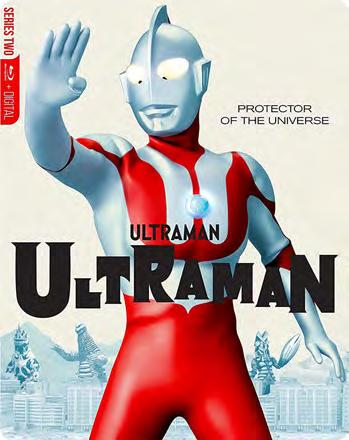

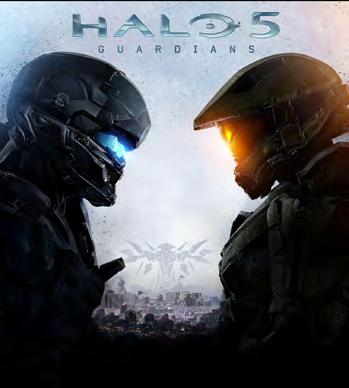
NT: At the same time, with the ability of making music interactive, some of the beauty we had back in the old days—just the linear music playing over and over, which became very memorable—doesn’t really happen anymore.
KJ: The implementation of the music used to be a lot more simple back in the old days. You would have a single wav file just looping over and over, whereas today you have all these individual chunks of music where you can let the program decide what to play so it really matches your gameplay, but musically it’s sometimes more difficult to make it memorable.
And what are some trends in the industry that you see growing over the next several years?
NT: The 3D audio, the immersive audio experience, that’s becoming more and more capable. In vr we are already working in more than stereo even though we only have a stereo environment, but we are heavily looking into immersive three-dimensional audio space. We are assuming that the kind of tech aspect of change will be happening more and, in fact, in the production we are in right now, we are exploring that [3D audio]. The tools are always advancing.
But that’s definitely the area we can explore. Because of the interactivity, there is no reason that we shouldn’t be placing music content in the speakers other than stereo. And so it really needs to be worked together with the game design and level design.
KJ: I would like to think it’s going to be less hectic to get music into the game, and less process to achieve better results, but you never know. That’s kind of my hope.
NT: Also, I see more potential in the mobile environment because of how handy the device is. One of the biggest companies in Japan is mobile-based. Their fan base is 100 percent mobile, and so having seen that I see more potential in those platforms.
How does scoring for VR differ from scoring something like Metal Gear Solid?
KJ: Well, it’s really the point of view. I do find
vr to be somewhat similar to a first-person shooter game, because you kind of have the same viewpoint. What you’re seeing is the character’s viewpoint.
This is just my way of approaching music for this kind of video game, but where possible I tend to back off musically, or not use music at all…not overload it with musical content, because you really need to experience the environment so when you come to the climax, that’s when you have really big, strong themes. That kind of contrast is really effective in the game. But if you’re working on games like Metal Gear Solid, you are watching the character and you’re an observer, so you sort of experience whatever the action is from a very different point of view. From my experience, you have a bit more room for musical expression if you’re observing the character.
Another thing to consider in the first-person experience is that the sound effects are pretty loud, so you need to watch out for it and you don’t want to fight with the other sounds. I mean, this really applies to anything with sound effects. This is something Nobuko taught me over the years: You see an explosion and you know there will be tons of sounds, so why do you need to have tons of instruments here? You can just back off a little bit and make room for it.
How do you see music evolving in the video game world? Are you starting to see new musical influences in video games?
KJ: I think the door will be more open to many different genres. Whatever fits the game. There’s no “Hey, [there are] lots of orchestral soundtracks, we should do this as well.” I feel that studios and audiences are really open to any kind of musical style.
A lot of Seattle-based composer friends of mine are very diverse, and the people that I do know personally are very musically diverse; some people work on electropop game scores then some people just work on orchestral things, and some people are doing jazz scores.
NT: One of the trends I’m sensing happening in Japan is that a lot of audiences are going away from traditional orchestral sounds and [toward] more heavily produced electronic
“I think the door will be more open to many different genres. Whatever fits the game.... Studios and audiences are really open to any kind of musical style.”
KAZUMA JINNOUCHI ’02
elements. Some people don’t even really like organic elements. I mean, probably from a u.s. point of view that might be a very niche thing, but that’s definitely one area of musical interest. Also, music that doesn’t really incorporate melody in a traditional sense is already happening in a lot of different mediums as well.
Geographically, where do you see the industry growing most?
KJ: I don’t really know the answer to your question, but just speaking of the West Coast there are a lot more indie studios than 10 years ago. For example, a lot of my ex-colleagues at Microsoft left big corporate and started their own [studios]. And there’s multiple of those in Seattle. I see more small studios doing interesting things.
NT: I have experience working with Singapore-based studios that have huge fan bases as well. And there are a few companies in Tokyo, relatively new companies, that managed to get very big fan bases.
What advice do you have for someone who wants to get into this industry, or what do you think a video game scorer today needs to have to succeed in the industry?
KJ: I can talk a bit more on the technical side of things, but this also applies to working on film. The content is built on the technology so understanding the workflow, terminology, and language that’s used in the production would be definitely helpful. Again, that continues to change because of just the nature of the industry; it just continues to evolve, so I think that being able to adapt to new technology and ways of composing music [is important]. And then, of course, being able to write good music is important. But, yeah, just understanding the medium, and then, especially for video games, if you really understand it, it really helps you write more functional and more effective scores.
And then getting to know who works on what games [is important]. Luckily for video games, there are lots of conferences and
people usually like to talk to people. And so getting to know the developer and understanding what their requirements are, and letting people know what you’re up to and what you want to do, is really important.
NT: [My advice is] to be an in-house composer.
KJ: Yes.
NT: When you work on a video game, from the director and designer side, you are part of the development team. Of course, you’re the composer and you’re part of the music, but before that you are part of the development team, so just really understanding where you stand compared to other people who make the game is really important.
KJ: We both learned that way of working by being in-house for many years, and so we know what it’s like to be in crunch time in the studio and trying to finish a game in a shippable quality. It may be hard to get a sense of what that’s like from the outside, but being part of the development team really means that you understand the process.
I forgot who gave me this advice, but someone early in my career said, “If you get to become an in-house composer, make sure you go through more than two companies; that way you learn different cultures and how different companies ship the game,” and that was very true.
Nobuko and I were both fortunate enough to go through big studios that release games worldwide, and [for which] there has to be achieved a certain level of success. There’s an expectation of the quality that we need to hit. At the same time, in a pinch, [we need to know] what needs to be a priority during the development and what needs to be cut off.
Does working in film and TV help you with your vidzeo game scores?
KJ: I think so. There are elements that don’t really apply in film that you learn in games and vice versa, but I think creatively it really helps. And more than just going between different mediums is working with different directors. They all have different methods of conveying the message, so knowing differ-
ent approaches and then being able to have those options creatively as a writer and producer is really helpful.
NT: I, on the contrary, feel that my experience in game music composition [helps] when composing music for film and television. Because the story is consistent, it is easier to psychologically manipulate the music, to place musical features…. Above all, we don’t have to create music that has 10 branches in one story. [laughs]
What do you like to listen to when you’re not working?
NT: I don’t want to listen to anything. I like silence. Whatever musical ideas I have in my head, I don’t want to be distracted [from them] by listening to some other music.
Do you ever listen to music?
NT: Only when I drive my car. The music provides me with a certain level of distraction so that I don’t get very tense.
What about you, Kazuma? What kind of music do you like to listen to in your free time?
KJ: I recently went back to listening to Vince Mendoza. He’s a really amazing arranger. I first bought his cd when I was at Berklee and was blown away with his writing. I listened to his album again recently and I keep going back to it; it’s just so inspiring. A couple months ago I was listening to a Japanese big band writer named Miho Hazama. She’s an amazing writer. I was listening to her album and it’s really great.
I listen to music on my own sometimes in the studio just to distract me from whatever I’m writing so that I can listen to my music with a fresh ear. I don’t really listen to music when I drive because it becomes a little distracting and dangerous for me. I start following the harmony, and I tend to miss a few things when I drive if I do that, so I thought that was a little dangerous.
NT: When I listen to orchestra when I drive, the same thing happens. It just gets [to be] too much—I would go the wrong way. [Laughs.]

“BARRIO MAYA AND MÚUL PAAX ARE TRYING TO SPREAD THE MESSAGE THAT, ‘HEY IF WE DON’T DO SOMETHING, A HUGE PART OF OUR CULTURE IS GOING TO BE LOST: OUR LANGUAGE,’” SAYS COFOUNDER AND MANAGING DIRECTOR GUIDO ARCELLA M.M. ’15.
The Mayan people of Mexico’s Yucatán Peninsula breathe new life into their ancient heritage, with help from a Berklee alum.
Itzincab, a village of little more than four blocks nestled in Mexico’s Yucatán jungle, is named after an insect that has played a central role in the local Mayan culture for centuries. In the Maya language, itzincab means “little brother of the bee,” in honor of the honey-maker that has traditionally provided food and medicine to the Maya. But, as with the indigenous stingless bee, the Maya language itself is in danger of vanishing.
Though many of Itzincab’s elders speak Maya, the younger generations mostly do not. The push to eradicate the language began with the Spanish conquistadors, but the threat to it today is from within Mayan communities, where it is sometimes viewed as a lower-status language relative to Spanish. Not only do Mayan children often not speak it at home, but those who use it in public are sometimes teased by their peers for doing so.
This stigma is one that GUIDO ARCELLA M.M. ’15 and his colleagues at Barrio Maya and Múul Paax are working to change. Arcella, who also runs a film scoring business and a recording studio, is the cofounder and managing director of both projects, which are trying to stem the loss of Maya and to support indigenous music. Barrio Maya is doing this by supporting both the continuation of Maya through rap and the musical aspirations of rappers on the peninsula, while Múul Paax creates and performs pre-Hispanic instruments.
“Barrio Maya and Múul Paax are trying to spread the message that, ‘Hey if we don’t do something, a huge part of our culture is going to be lost: our language,’” Arcella says.
Part of that “something” the groups are
doing is using music to help the Mayan community restore pride in its culture and see its heritage as something worth preserving.
“You don’t appreciate what you don’t know,” says Nadia Zupo Herrera, the stagecrafting director for Múul Paax. “If you make it a daily practice to be exposed to Maya it becomes normalized and appreciated.”
The idea for the projects came to Arcella after he graduated from Berklee Valencia with a master’s degree in scoring for film, television, and video games. Arcella, a 32-year-old from Argentina, returned in 2015 to the Yucatán Peninsula, where he had lived for a time as a child in a Mayan village because of his father’s job in the area’s hospitality industry. Fresh out of the graduate program, he started a series of Mayan music labs at Hacienda Ochil, which was once a cattle ranch and henequen farm but now serves as a venue for private events and art projects.
Inspired by the success of these labs, Arcella wanted to figure out how to tap into the musical opportunities they presented. He reached out to Berklee Valencia’s International Career Center for ideas and was advised to contact fellow alumnus GAEL HEDDING B.M. ’05.
Hedding happened to be home, in Cancún, when Arcella got in touch with him in January 2017. “Having grown up in the region, I have an understanding of the challenges and opportunities that exist among Mayan communities,” says Hedding, who is now the director of the Berklee Abu Dhabi Center but remains an active advisor to Múul Paax and Barrio Maya.
The pair collaborated on a couple of events in which Hedding did live sound and production support. “Guido’s enthusiasm and dedication was infectious,” says Hedding. Together, they began brainstorming the best way to leverage the Mayan community’s talent and potential. “We noticed that Mayan rap and pre-Hispanic instrument fabrication were both worth supporting, and that such support needed to happen through the form of education,” Hedding says, explaining how he and Arcella came up with the idea to start Barrio Maya and Múul Paax, which were, and continue to be, incubated by Fundación Haciendas del Mundo Maya (fhmm), a nonprofit Arcella’s mother directs that focuses on promoting cultural activities, nutrition, infrastructure, and economic and social enterprises in Mayan communities.
As Arcella and Hedding were considering where to take these projects, Arcella started two other endeavors that he still runs today: Arcella Sound, his film and video game scoring business, and Casona Indie Music Studio, his recording studio staffed with an engineer. It was at Berklee Valencia, he says, that he really learned how to run a studio, how to make his music sound professional, and how to use production tools to make that music shine.
Arcella manages to balance his leadership of these two projects with his own artistic work. This summer, Arcella was working on scores for two movies and two video games, in addition to numerous other engagements, including giving a master class in Mérida on soundtrack design in film; auditioning child musicians to be part



of a group that would play at Festival Paax on the Mayan Riviera; and giving film and game composition workshops at the Musicians for the World event in Peru. Within the last year, he’s also done an artistic residency at Southern Methodist University in Dallas, where he had received his undergraduate degree in music composition and violin performance.
One of the ways Arcella and Hedding launched their initiative, in 2018, was by offering weekend classes in Ochil, and later Temozón, to children aged 5 to 18 as part of a project they called Múul Paax, which means “music among us” in Maya. Divided into three groups by age, the kids would rotate among instructors who would teach them stagecraft and choreography, instrument construction, and music theory. Some children would also learn how to play instruments. During the week, the 50 or so participants would disperse back to their communities and rehearse in their villages’ cultural centers.
But, as with nearly every other group activity in the world, these classes ended in the spring of 2020. As the pandemic progressed, Arcella and his team looked for new ways to keep the children involved. For the youngest students, Múul Paax provided education through Zoom video calls, which culminated in recorded video projects in each of the participants’ communities. In these videos, the students dressed
in costume to personify the animals and food found in a Mayan milpa, or cornfield and garden.
One girl who participated in the program, Sinahi, said it made her happy because she got to meet children from neighboring towns and learned many new things, such as how to play the flute. As is common for children in the area, Sinahi, now 11 years old, had never had any music education.
To complement the Zoom instruction, Arcella’s studio made a series of audiobooks explaining Mayan cosmology through a child’s eyes. The series, called Llamada del Caracol (“Call of the Shell”), aired on national radio.
Meanwhile, the oldest group of Múul Paax students, who lived mostly in the Campeche town of Bolonchén de Rejón, gathered in the local park to pick up the on-and-off WiFi signal on their cell phones and connect to lessons over WhatsApp. It was this group that acquired its own space, also in Bolonchén, where they could get together twice a week to work on building their instruments and practice playing them, which they continue to do today.
‘We Are Them’
During one of these semiweekly sessions, in mid-June, 17-year-old Angel Nah Abnal stood behind a table that held an array of whistles, flutes, rattles, and conches, and went through the function and purpose of each one.
He first picked up a vase-shaped ves-
sel no larger than his hand, cupped it, and blew into the neck. As he slowly removed his palm, the instrument released a whooshing sound that mimics the roar of a jaguar, an animal native to these parts. Another pocket-sized object, which had an inscrutable little face carved on it, is called a silvato de la muerte (“whistle of death”); it produced a shriller sound. This is the instrument the Maya would play to scare off their enemies during battle, Nah Abnal explained.
In a way, Nah Abnal is also using the whistle of death to defend his people. “I think it’s important to raise this Mayan culture because the new generations are ashamed to belong to the Mayan culture, and that is a big mistake because we should feel proud of our culture and what we are,” he says in a video about Rap & Raíz (“Rap and Roots”), a collaboration between Múul Paax and Barrio Maya in which the two groups offer joint concerts.
Nah Abnal’s sentiment is widely shared in Múul Paax. His bandmate and brother, José Nah Abnal, says that Múul Paax aims to rescue Mayan music through the instruments. “Because we come from the Maya, more than anything, we need to respect this type of music,” he says. “It’s our origin.” José Nah Abnal plays turtle shell as well as tunkul, a carved-wood percussion instrument that produces two tones, one to symbolize the day and the other the night. It represents, he says, the duality of nature.
Standing next to the brothers was 18-yearold Angel Poot Tec, who plays the zacatán, a drum made out of a tree trunk and deer skin. He says he too is concerned about people

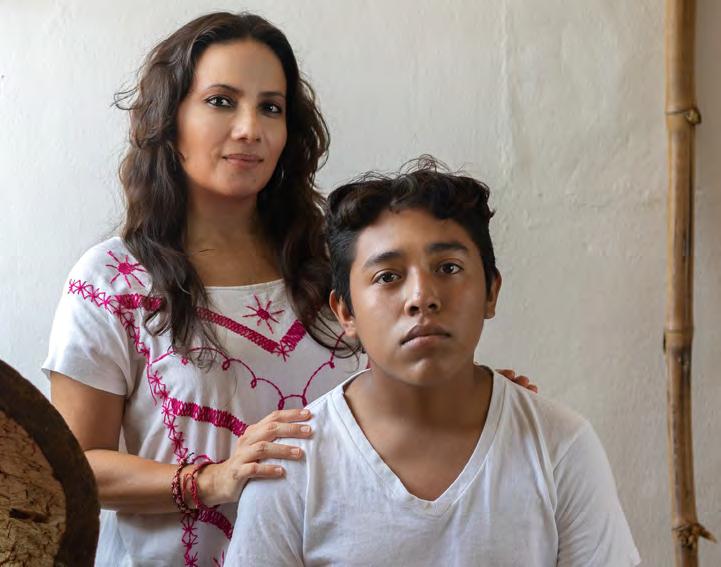
abandoning the culture.
It’s this feeling of loss of culture that inspired the group’s leader, Roman Dzul, a local music instructor, to put together the group Yum Paax (“God of Music”) seven years ago to teach children Mayan ritual music. Several members from this group joined the Múul Paax project. This group then turned into what is now Múul Paax. For Dzul, it’s important to pass this musical tradition to the young to keep it alive.
One way to ensure this legacy, says Pedro Salvador Hernández, the group’s instrument construction consultant, is to give Mayan performers the ability and know-how to build their own tunkuls, zacatáns, ocarinas, rainsticks, and the like.
Though they can’t be sure that the instruments they build are exactly what their forebears used, they know from ancient paintings and evidence from archaeological digs the type of instruments the Maya of pre-Hispanic Mexico likely played.
However, it would be a mistake to speak of this civilization as one that existed only in the past. “They say the Maya are not around anymore, but that’s a mistake. They still exist; we are them,” Dzul, the teacher, says.
This year, Múul Paax has had four or five big concerts around the Yucatán Peninsula, and has performed at various Mayan ceremonies, such as those to bring rain. These concerts include the group’s Rap & Raíz collaborations with Barrio Maya, which provides a logistical and educational platform for the development of Yucatán rappers who incorporate Maya into their rhymes.
One rapper who’s benefited from Barrio Maya’s programming is a 21-year-old from Espita who calls himself la2c. He began rapping at age 11 and soon had ambitions to record. But living in a small town that’s a two-hour drive from either Mérida or Cancún, he had little access to studios. That is, until a local gang offered him the opportunity to use the recording facilities belonging to one of its members.
“I was part of the gang but not because I wanted to be but because they were giving me the possibility to record,” la2c said.
As a reluctant member of the gang, la2c says he found himself in many conflicts. These culminated in an incident that changed his life. At 14, he was part of a fight that left him badly beaten and unconscious. When he came to, he realized that he had been deposited a block from his home, saved by an adult he didn’t know and hadn’t seen in town before. It felt, he says, like divine intervention. He considered it a second chance and realized that day that he wanted to dedicate his life to doing good. He left the gang and renewed his focus on his music.
Today, he works with a Mayan rapper and producer who goes by the name Masewal, which is Maya for “indigenous guy,” and la2c ’s lyrics, a mix of Spanish and Maya, are about spreading positivity. On a day this June in Masewal’s studio, moments after la2c describes his story, he performs his song “Bienvenidos a Yucatán.”
He starts, in Spanish: Welcome to my state, welcome to my land
You are all invited. If you come here, you stay
Because you will truly fall in love with its festivities, traditions, its stories
And embroidery of my mestizo people
Of the Maya people, my culture is first
About halfway through the tune, he switches to Maya and tells a story about a day in the life of an indigenous man who gets up, goes to the milpa, cuts some wood, and spends time with his family.
As he’s rapping this, he’s steps away from the milpa belonging to Masewal’s family. Though loosely translated in English as “cornfield,” a milpa is a system that traditionally provides the Maya with all their needs for a comfortable life, including corn and other crops, medicinal honey, and material to build houses, says José Arellano, fhmm’s biodiversity senior advisor.
These days, some young Mayan men are also seeking different ways to find a comfortable life. la2c, like many others in the peninsula’s interior, makes his living by working in construction in the booming Mayan Riviera, where luxury resorts have sprung up from Cancún to Playa del Carmen to Tulum. This influence is also showing up in la2c ’s rhymes. In “Bienvenidos a Yucatán,” he raps:
We are truly fortunate to have what we have
That we earned with effort
My culture is universal
It is always recognized all over the world
Everyday they visit it and admire it
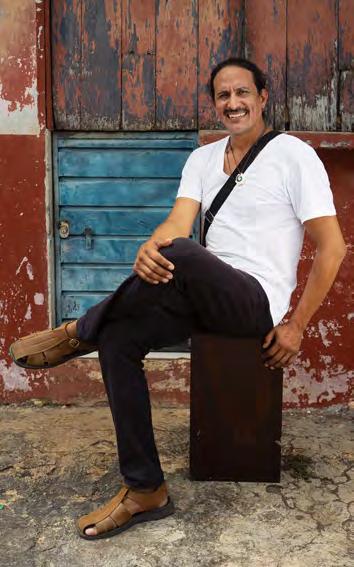
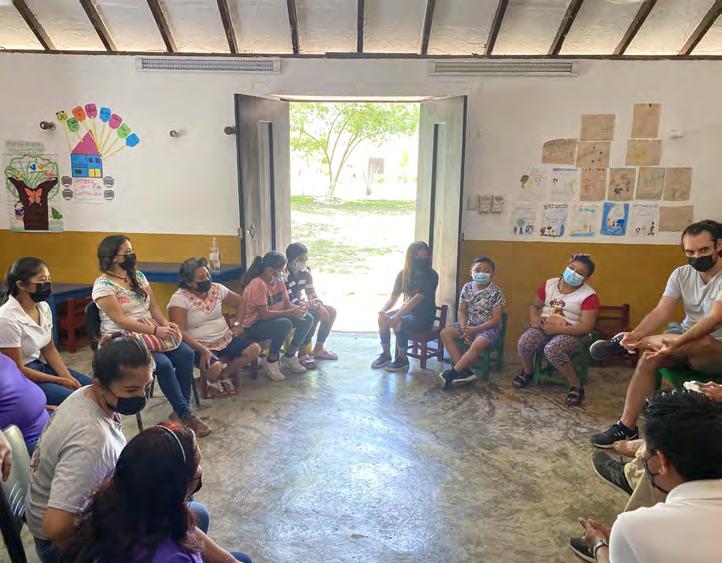
Its gastronomy, cenotes, and its beautiful beaches
la2c ’s rhymes flow easily over the tune’s catchy beat. “Barrio Maya helped me to professionalize the music of my songs,” he says in the Rap & Raíz video. “They trained me in approximately 10 weeks, starting with music theory; they taught me to compose, to make the basis of a track. And then I learned to structure a lyric with coherence.”
Barrio Maya delivered this instruction through video content. The prerecorded lessons, offered annually through a free 10week series called Make Rap Music from Your Cell Phone, cover music technology to help rappers make their own beats in a software app; lyric writing, including in Maya; stagecraft and choreography; and general master classes by another rapper.
la2c started rapping in Maya about five years ago, shortly after he met Masewal, who himself had started rapping in Spanish before switching to Maya. The two rappers speak Maya at home, but Masewal says he noticed that people are forgetting how to speak it. As with the members of Múul Paax, Masewal says it’s important for him to rescue this part of his identity and to let people know about his culture and music.
Another rapper at Masewal’s studio that day in June, a 26-year-old who goes by the name Verso Maya, emphasized that there is no contradiction between embracing rap— and the style that often goes along with it— and being Mayan. Even though they might dress differently from what some might expect of people from his culture, they are
still Mayan, he said.
“Rap, Barrio Maya, Múul Paax and other projects are looking for the people to be proud of their culture, and their music, and their food,” says Fernando Santandreu, the groups’ education coordinator.
Though both groups are currently incubated by the nonprofit fhmm, they help support themselves through concerts, such as Rap & Raíz, instrument sales, and some fundraising. In addition, Arcella ran an online film scoring competition called Rec Change from 2019 to 2021 to help raise funds for Barrio Maya. Still, he says, a major goal of his is to make the groups self-sustainable by gaining the long-term financial support of more organizations.
Barrio Maya and Múul Paax continue to collaborate in ways beyond the Rap & Raíz concerts. One might think that acoustic pre-Hispanic-inspired music might not mesh well with rap but, says Santandreu, the combination is actually a new and surprising way to make music.
Back in Itzincab, the town named after the bee, children gather in the town’s cultural center to describe their experience with Pat Boy, a well-known Mayan rapper who worked with them a year before their workshops with Múul Paax.
Pat Boy, who is from the neighboring state of Quintana Roo, had received a federal grant in 2019 to hold a cultural workshop and contacted Arcella for ideas on what to do.
What resulted was a workshop in Itzincab for children aged 8 to 14 in which the rapper worked with the kids over the course of three months, teaching them to put together a rhyme in Maya, build a song, and record the final product.
The children, now in their early teens, said it was a lot of work: They had to study Maya, learn a bit about various rap genres, practice how to move during a performance, and familiarize themselves with the basics of recording and production, such as how to use a microphone.
It was an opportunity, Pat Boy said in a video about the workshop, for the children to learn that Mayan rap exists and to see what can be done in the Maya language. “Many people apparently do not speak Maya. But with this workshop many have already become interested in learning phrases, saying things in Maya,” he said.
The children describe the process as a happy and emotional one. Everyone in town was very proud when the song, in which a little iguana is invited to town to enjoy some food, was posted on YouTube. In school, teachers played the recording for the children to enjoy and dance to.
And despite some bullying from kids in a neighboring town who derided the novice rappers for using Maya, the children smile when they describe their time with Pat Boy and remember the song and video.
“Everyone has a goal. Maybe it’s to become a writer, a poet, a teacher—whatever it might be,” Pat Boy said. “But now they see the great importance of what the Mayan language is, [and] what can be done as an artist.”


GLOBAL PARTNER SPOTLIGHT
THE INTERNATIONAL COLLEGE OF MUSIC


Known for its rigor, Kuala Lumpur’s International College of Music has set up hundreds of students for success at Berklee over the past 25 years.
STORY BY Rebecca Beyer


JULIAN CHAN B.M. ’01 was a 16-year-old trumpet player in Malaysia’s Sarawak State Symphony Orchestra when he first fell in love with the idea of being a sound engineer. The orchestra had traveled to Monash University in Australia for a week of classes and performances, and Chan had noticed all the people working behind the stage during concerts.
“Brass players tend to have a lot of rest,” he says, laughing. “My mind would start to wonder, and I was really drawn to what the tech guys were doing.”
On a visit to the university’s music technology department, Chan asked someone how he could break into the field. The man had one tip: Berklee College of Music. When Chan returned home, he persuaded his parents to let him pursue his dreams. Then, just as he was ready for college, the Malaysian economy took a dive, making the cost of Berklee prohibitively expensive in Malaysian ringgits.
“We were thinking, ‘This isn’t good. This might not happen,’” Chan remembers.
Fortunately for him, the principal of his music school recommended he look into a new contemporary music college in Kuala Lumpur. The International College of Music, or icom, had just launched a formal partnership with Berklee.
“ icom became the lifeline,” explains Chan, who began there as a student in 1998.
For aspiring musicians in Malaysia, icom is still a lifeline. Since 1997, nearly 200 of
its students have transferred to Berklee through its official status as a Berklee Global Academic Partner school.
Formerly part of the Berklee International Network (bin), Global Academic Partner schools have credit-transfer agreements with Berklee, allowing students to complete core music courses (known as the Berklee track) at the partner school. A major benefit of such partnerships is the cost savings.
bin first launched in 1995, with three schools: Philippos Nakas Conservatory in Greece, Rimon School of Music in Israel, and l’aula de Música Moderna i Jazz del Conservatori del Liceu in Spain. Gary Burton and Larry Monroe, under the leadership of then-President Lee Eliot Berk, spearheaded the program.
“It came from seeing the need to diversify our enrollment, to create more pathways for people from outside the United States to get access to the Berklee education,” explains Jason Camelio, assistant vice president of Berklee Global Initiatives. “The avenue they saw to do this was to work with institutions that were like Berklee—typically those are places where Berklee graduates have gone and set them up, taken a germ of the Berklee genes, and planted it in that community and culture.”
Today, Berklee has 25 Global Academic Partners, including three in the United States. The schools are “like a bridge” to Berklee in Boston, Camelio says. “Students get this core music experience, and then they tend to get accepted on a higher level, to get scholarships, to do incredibly well academically, and to graduate at a higher level.”
Since 2015, only two other Global Academic Partner schools—sja Music Institute in South Korea and Rimon School of Music—have sent more students to Berklee than icom has. Eighty-two percent of students who transfer from icom graduate from Berklee, compared to 70 percent who come from other partner schools. (Across Berklee, the graduation rate in 2022 was 67 percent.)
icom’s success is due in part to IRENE SAVAREE B.M. ’88 , the school’s founder, president, and chief executive officer. In the mid-1990s, after a successful singing career in Malaysia as a solo act, and with her sister, HELEN SAVARI-RENOLD B.M. ’88, Savaree was approached by investors to start a music school in her home country.
“They had one caveat,” she explains. “They said, ‘You need to have some kind of an institutional tie-up with Berklee.’”
In 1997, when icom formally became part of bin, the Malaysian prime minister and the heads of many of the country’s music labels attended the formal signing ceremony.
Students in icom’s Berklee track, also known as the Foundation in Music program, take courses in music theory, contemporary harmony, ensembles, music technology, ear training, and traditional harmony, among other subjects. The program is open to anyone, not just those planning to go to Berklee. (The school also offers diplomas in sound production and in music.) After a full year in the Foundation in Music program, students are able to transfer as many as 54 credits to Berklee, where they can focus on their specific majors.
“If I didn’t have this pathway to Berklee, I might


“I think the role that icom has been playing and is still trying to play is to instill that foundation in students to be able to excel not only at Berklee but also to thrive in a professional environment,” says ALI AIMAN B.M. ’10 , who heads icom’s Berklee track. “It’s quite a rigorous program.”
The rigor pays off. Berklee student Will Tiong, a vocalist who hopes to work on the business side of the industry, says he “butchered” his audition to icom because he had no previous experience in ear training or sight-reading. After a year at icom, however, he nailed his Berklee audition and even received a scholarship.
For Tiong, who enrolled at icom specifically for its Berklee transfer program after initially studying finance at another institution, icom had several advantages, including its cost savings and the opportunity to study music formally without a four-year commitment.
“I was making a big switch at the time,” he explains. “The low commitment level appealed to me. It was a good test to see if I really did want to go into music, and it turns out that really was what I wanted.” This summer, Tiong interned with a record label and with a music marketing guru who tapped him to run Barbra Streisand’s TikTok account.
The icom community is small and closeknit: About 120 students are currently enrolled and about 15 faculty, including several Berklee and icom alumni, teach on campus.
Students and faculty regularly gather just outside the school’s doors where a vendor sells coffee, tea, soda, boiled eggs, and local cakes.
“Lecturers go out there, students go out there, and we’d talk about our experiences,” Chan remembers. “This is what I think was special during my time.”
Although students are generally academically prepared for Berklee, they still often experience culture shock when they arrive in Boston.
“The biggest shock is just how big it is and how diverse,” Chan explains, adding that his transition was eased by the fact that everyone seemed to be in the same boat. “It helped that everyone you were meeting was in some way or another not from [Boston].”
NISA ADDINA B.M. ’18 , a violinist who first learned about Berklee from her mentor,
SHAFIEE OBE B.M. ’87 , says being able to go to Berklee with friends and classmates from icom helped her transition.
“I wasn’t feeling so alone,” Addina says, adding that the Malaysian students at Berklee got together often.
Since ic icom om is a hub for music students from across Asia, its transfer students at Berklee also include people from China, India, Indonesia, Japan, the Philippines, Singapore, and South Korea, among other countries.
Several members of Savaree’s own family have gone to Berklee. In addition to her and her sister, four of her nieces and nephews have attended, including two who transferred from icom.
“It’s been a wonderful relationship,” Savaree says. “Besides the Berklee brand, which opens doors, what I personally find very valuable in the Berklee-icom relationship is the sense of community.”
SHEREEN CHEONG B.M. ’17 echoes that sentiment. When she served as music director for one of Victory Boyd’s shows in Los Angeles, Cheong called everybody she knew from her time in Boston and was able to fill out the horns section and a string quartet.
“It was a mini-Berklee reunion,” she says, laughing. “It was very warm.”
icom’s Berklee track has paid off for others as well.
“If I didn’t have this pathway to Berklee, I might not be doing what I’m doing now,” says Chan, who has done sound mixing for video games including Guitar Hero and Rock Band, and now works for the Eagles’ Don Felder as an engineer.
SOYA SOO B.M. ’15 agrees. As a teenager in Malaysia, he noticed Hans Zimmer’s name popping up in the credits of his favorite films and video games; today, he works as a studio engineer for Zimmer’s Remote Control Productions in Santa Monica, California. In his career so far, Soo has collaborated with the film composer John Powell on Solo: A Star Wars Story and FERDINAND , and has worked with Zimmer on Dune, The Lion King, and Dark Phoenix, among other projects.
not be doing what I’m doing now.” JULIAN CHAN

“Without icom, I couldn’t go to Berklee, and, without Berklee, I couldn’t learn all the technology or know anyone in the industry,” Soo says. “I wouldn’t be where I am.” CAPTIONS HERE
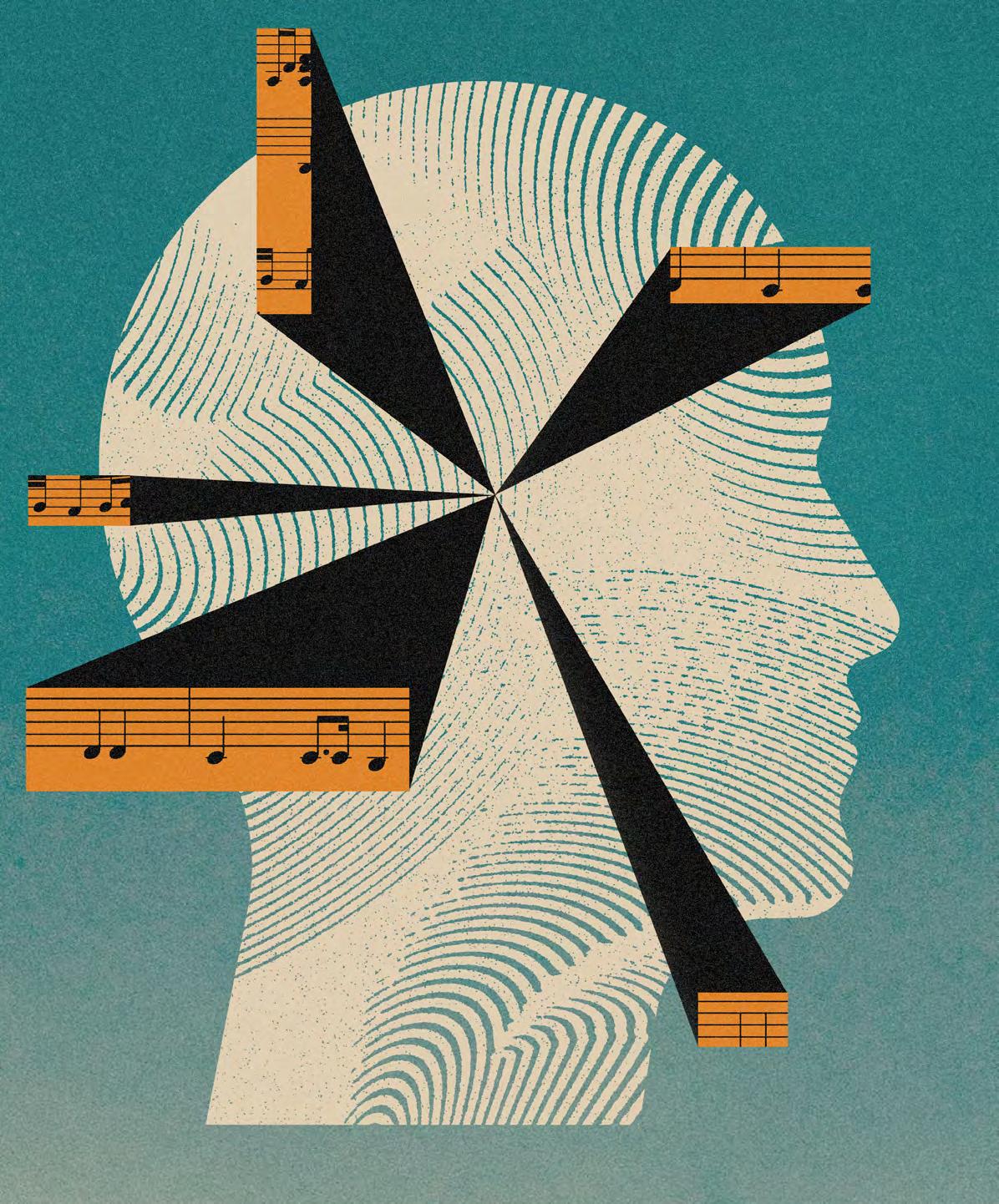
A SPECIAL SERIES TRACKING EVOLUTIONS IN THE MUSIC
As evidence of music therapy ’s benefits grows, the practice is increasingly showing up in hospitals, schools, and more.
STORY BY Susan Gedutis Lindsay
“There were hardly any music therapy departments in hospital settings. It was even more rare to see a music therapist who had an administrative role over a department.”

It was only 15 years ago that music therapy was still considered to be at the periphery of medical practice. At the time, Rich Abante Moats was at Berklee, studying to enter the field.
“There were hardly any music therapy departments in hospital settings,” she says. “It was even more rare to see a music therapist who had an administrative role over a department.” But today, as director of Integrative and Creative Arts Therapies at AdventHealth in central Florida, MOATS B.M. ’07 M.A. ’19 oversees a team of 12 music therapists who work with adults and children in a variety of inpatient and outpatient hospital settings: icus, surgery, oncology, neurology, covid, and neonatal units.
AdventHealth, Moats says, now recognizes that music therapy benefits not only the patients, but also the business side of hospital care: “People are able to leave the hospital sooner if they receive music therapy. Patients that receive music therapy score their experience higher than others.”
AdventHealth is one of many health care institutions around the country that have embraced music therapy in recent years. In Boston alone, there are now eight music therapists at Children’s Hospital, and six at Massachusetts General Hospital; both programs made this expansion in the last 10 years. In 2017, the National Institutes of Health collaborated with the John F. Kenne-
dy Center for the Performing Arts and the National Endowment for the Arts to form the SoundHealth initiative to provide $20 million for music therapy research.
Thanks to years of studies supporting music therapy’s benefits, demand for music therapy is growing in a variety of clinical and community settings. A half-century of effort by board-certified professionals is finally codifying the practice and demonstrating its impact on concrete health outcomes.
The field now abounds with well-paid clinical positions, and a handful of states are licensing music therapists beyond the expected board certification. “The music therapy field is flourishing,” says Joy Allen, chair of Berklee’s Music Therapy Department.
According to a September 2022 report by consulting firm SkyQuest Technology, the American Music Therapy Association estimates that the demand for music therapy in the U.S. has doubled in the last five years. The report also notes that U.S. Bureau of Labor Statistics numbers indicate there was a 17 percent increase in job openings for music therapists during roughly the same period.
Music therapy effects positive changes in patients’ well-being by involving them in live music-making. The music, often im-
“The music therapy field is flourishing.”

provised, is made using a wide variety of instruments—including guitars, ukuleles, percussion instruments, keyboard, and the voice. It draws on a range of genres and styles, as patients are encouraged to use their own natural musicality to express themselves and to connect with others. Through this music, therapists teach relaxation, techniques to cope with pain, and tools for managing stress and chronic illness. The therapy can be particularly helpful in getting patients to process emotions that they are unable to express in words. The work can be done individually or in groups, depending on need.
“Music affects areas of the brain well beyond cognitive areas, including parts that affect mood, feeling, and emotion,” says Suzanne Hanser, chair emerita of Berklee’s Music Therapy Department. “Music therapists can focus on these areas to develop new pathways in the brain.”
The field is also benefiting from a cultural shift in medicine: a growing awareness of the value of a patient’s quality of life. “As science has advanced in terms of ‘curing’ and mitigating some of the losses from illness, it mandates more opportunities for behavioral health and rehabilitation sciences,” Allen says. “This shifts the emphasis to discovering what is meaningful for an individual and finding therapeutic means to help them meet health challenges they need to learn to live with.”
Researchers and educators like Hanser are playing a critical role in continuing to establish the practice. She wrote a seminal music therapy textbook, The Music Therapist’s Handbook, in 1988, founded Berklee’s Music Therapy Department in 1995, and chaired it from 1996 to 2015.
“These last 10 years, the biggest change was that we went from the Western medical disease model—the whole idea of the disabilities, the disease of [people] who had so many abilities,” Hanser says. “Now we’re moving far away from diagnostic categories and disabilities and looking at the whole person.”
As research began to show positive health outcomes associated with practices such as meditation, yoga, acupuncture, and traditional Chinese medicine, the science of mind-body medicine has grown, and music therapy is part of it, Hanser says.
The practice is also finding stronger footing in public schools. NOA FERGUSON B.M. ’09 is in her eleventh year of providing music therapy to schoolchildren as cofounder of Spectrum Creative Arts in Rochester, New York. Her team of five music therapists serves 50 schools in 12 districts.
“In the past 10 years that I’ve been a clinician, music therapy has become a licensed profession at the state level in a handful of states across the U.S.,” Ferguson says. (All U.S. music therapists share a board-certification credential.) “Here in Roches-

“Music affects areas of the brain well beyond cognitive areas, including parts that affect mood, feeling, and emotion.”
“Here in Rochester, music therapy has started to become a household term that caregivers know to advocate for within their school districts and education systems.”
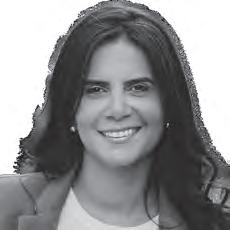
“Therapists were adapting and changing interventions we once thought were rigid to help clients achieve things in music they never thought possible before.”

Noa Ferguson
ter, music therapy has started to become a household term that caregivers know to advocate for within their school districts and education systems.”
As awareness of the field increased, its applications have broadened. “The field started changing for me as soon as I stepped into clinical practice in 2004,” says MARLÉN RODRÍGUEZ-WOLFE B.M. ’08, who works as chief executive officer for the Ukulele Kids Club, a Florida group that uses music to improve the well-being of medically fragile children. “Seeing the clinical work being done in hospitals, treatment centers, and community centers around Massachusetts, which was not yet reflected in the literature, was very exciting. Therapists were adapting and changing interventions we once thought were rigid to help clients achieve things in music they never thought possible before.”
Meanwhile, advances in neuroscience have allowed researchers to better measure the effects of music therapy on the brain. The Music in Neurodynamics (mind) Lab at Northeastern University, for example, recently used brain imaging to demonstrate the brain’s auditory and reward systems working closely together when stimulated by music.
“Brain imaging has shown that the ar-
eas of auditory memory—in other words, memory for sounds and music—are distinct from the areas that are particularly affected by diseases like Alzheimer’s,” Hanser says. “The areas of the brain that preserve music are active, which accounts for the many anecdotal reports we had for people in nursing homes who suddenly start singing all the words to a song when they haven’t talked in years. When we have that kind evidence, it’s really hard to justify not providing it, because that area is still intact.”
Such discoveries are part of what prompted a redesign of Berklee’s music therapy program under Allen. In 2018, the college launched the Berklee Music and Health Institute to focus on clinical research in music therapy, and last year the Center for Music Therapy at Berklee was established to advance community-based approaches. This fall, Berklee will launch a minor in music and health so that students can explore the intersections between music, health, and overall well-being, including professional opportunities for engaging in both disciplines.
“It feels like opportunities have expanded significantly in just seven years,” Hanser says. The field continues to grow as music therapists help heal patients, one by one, and researchers explore how music is processed by the brain. “What’s the mechanism behind why music does this to people?” she asks. “That’s fascinating to everybody.”


from Our Faculty Community
A CONSEQUENTIAL CAREER DURING HIS 28 YEARS AT BERKLEE, JAY KENNEDY, WHO RETIRES IN DECEMBER, REVAMPED

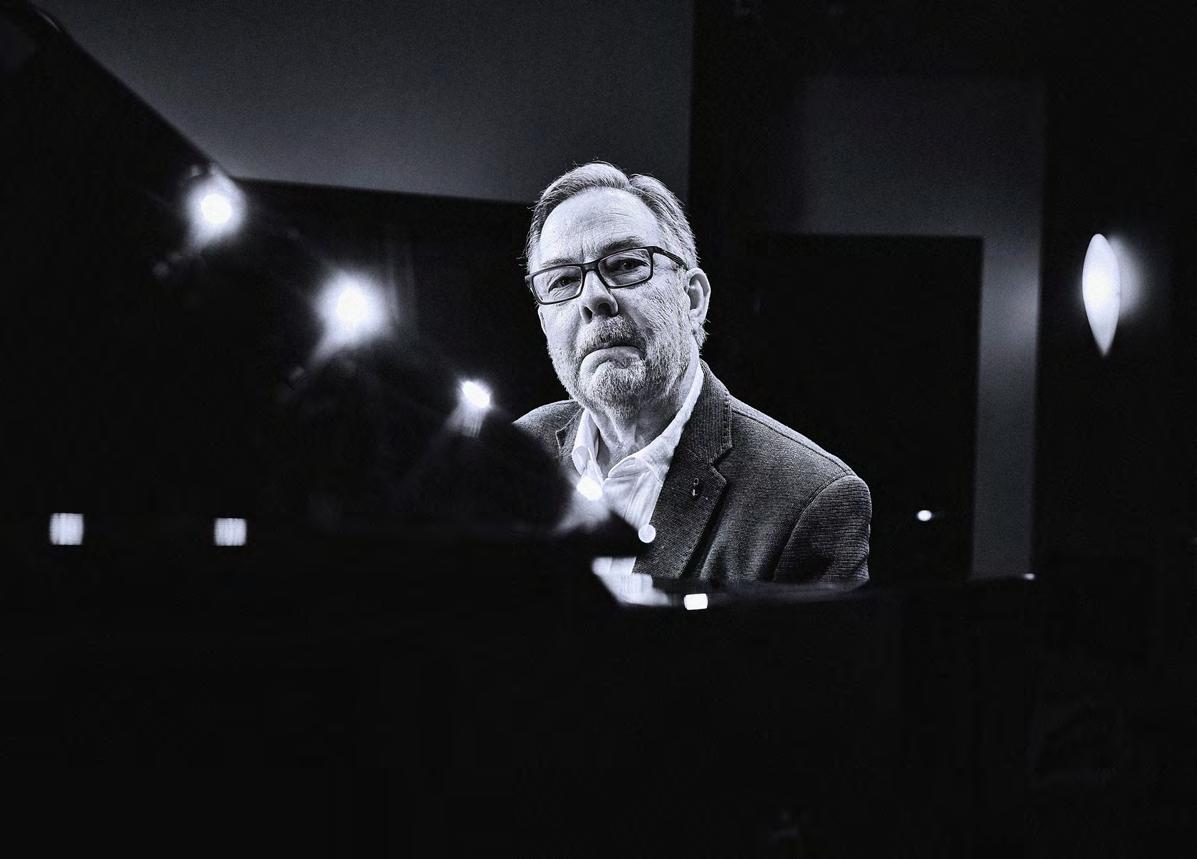
JAY KENNEDY HELPED CHANGE THE CONTEMPORARY WRITING AND PRODUCTION CURRICULUM TO BETTER REFLECT WHAT WAS HAPPENING IN THE MUSIC INDUSTRY.
One could feel exhaustion just reading the long list of Jay Kennedy’s accomplishments during his 28 years of service to the college and the achievements of his pre-Berklee musical career. The indefatigable Kennedy will retire on December 5 after a consequential career as Berklee’s vice president for Academic Affairs and vice provost. “It’s been fun,” he says with characteristic understatement. “There has been a variety of things that have kept me interested and engaged that I hope have in some way benefited Berklee.”
Kennedy’s expertise and labor on some of Berklee’s highest-profile initiatives have indeed been impactful. For the launch of the Valencia campus, he worked on space design, financial planning, and curriculum and policy development. He also oversaw academic space planning for the recording and technology facilities at 160 Massachusetts Avenue and the renovation and updating of Berklee’s other academic buildings as well as recording studios A and C. He has stewarded Berklee’s capital and academic equipment operating budgets, and managed the implementation of the laptop purchase pro-
gram and a reorganization of the Academic Technology Division. He expanded internships and experiential-learning opportunities for students, and assisted with the integration of Boston Conservatory faculty members into the Berklee Faculty Union. These are only a few highlights.
Additionally, Kennedy deployed his formidable musical skills at Berklee by arranging and conducting music for several concerts in the Great American Songbook series and by producing the 2018 commencement concert celebrating the music and lives of Nile Rodgers, ESPERANZA SPALDING B.M. ’05 , and Rosanne Cash, who all received honorary doctorates that year.
Kennedy has also served outside of Berklee as an adjudicator for drum and bugle corps, marching bands, and indoor percussion ensembles, as well as a composer and arranger for drum and bugle corps, percussion ensembles, symphonic wind bands, and jazz acts. Notably, he penned arrangements for the Grammy-nominated Virtuosi album by vibraphonist GARY BURTON ’62 ’89H and pianist MAKOTO OZONE ’83 ’03H
“I love all kinds of music,” he says. “I
am involved as a judge and administrator for Drum Corps International and have been judging for them since the mid-seventies. For 10 or 11 years I wrote for one of the groups and was the brass arranger and program coordinator for the Boston Crusaders.”
Kennedy, who spent his childhood in Franklin, Pennsylvania, and high school years in Kenosha, Wisconsin, left a successful career in Los Angeles as a jingle writer and orchestrator for movies and television to accept a post in 1994 as chair of Berklee’s Commercial Arranging Department. “The job description for the chair position described what I’d been doing every day: using technology to create tracks and combining acoustic instruments with electronic ones,” Kennedy recalls. “At that point, I had been doing jingles for almost 20 years, starting in Chicago and later founding my own jingle company in L.A.” During this time, Kennedy wrote commercials for such corporations as Coca-Cola, Pontiac, McDonald’s, and Nike, working regularly with top L.A. studio musicians, including Berklee alumni, such as VINNIE COLAIUTA ’75 , NEIL STUBEN -
“Keeping the student experience at the forefront has always been the guide in making these decisions.”
HAUS ’75 , and ABE LABORIEL SR. ’72 ’05H . For various reasons, Kennedy felt the time was right for a change of career and locale, and moved his family to Boston.
“Berklee’s arranging curriculum hadn’t caught up with the technological tools arrangers were using,” he says. “I was charged by Joe Smith [Berklee’s Writing Division dean at the time] to bring things up to speed. With help from faculty members, we designed new courses, updated several, and eliminated a few. We also changed the department name to Contemporary Writing and Production to reflect changes that were happening in the music business.” Kennedy and his colleagues also added business courses to teach students about contracts, fee structures, and more.
Incorporating new courses wasn’t hard, but eliminating some existing ones was, he says, adding, “There are so many choices for students, but you can’t do everything. We strive to maintain history and tradition in the curriculum while addressing how students are learning today and where they will be going in the industry.” The mixture he landed on paved the way for contemporary arranging and production to become the third most popular major at the college.
In 2001, Kennedy became Berklee’s assistant vice president for Academic Affairs, and was later named vice president for Academic Affairs and vice provost. “I might be weird for saying this, but I’ve always enjoyed administrative work,” he says, laughing. “I like being involved in strategic conversations about the direction of a division or the whole institution and helping people do what they want to do and become more successful.”
His favorite part of his job? “Of course,
the people,” he says. “I enjoyed working with the students as a department chair and on the concerts I produced with student musicians. I enjoyed their energy and freshness. Working with faculty members has always been a highlight. They are creative and energetic and bring so much to the institution. It’s been great working with the upper administration and trying to determine where we go next and balance the desires with the pressures. Keeping the student experience at the forefront has always been the guide in making these decisions.”
In retirement, he plans to dive deeper into writing music for winds and percussion, and to continue to judge in marching-arts activities. In July, a new piece by Kennedy was performed in Washington, D.C., by the U.S. Army Field Band “Pershing’s Own.” Kennedy has maintained ties to Northwestern University, where he earned his bachelor’s degree in music education and master’s degree in percussion performance. (He later earned a Ph.D. in higher education administration from Boston College.) Northwestern University Symphonic Wind Ensemble has commissioned works from him and featured his music in performances earlier this year. His longtime friend and colleague (and now fiancée) from Northwestern, Mallory Thompson, is director of band programs and heads the conducting program at Northwestern and champions symphonic wind music. This fall, Kennedy will marry Thompson in Evanston, Illinois.
As for the upcoming changes in his life, Kennedy says, “I look forward to not having to get up for nine o’clock meetings! I anticipate staying busy doing the things I haven’t been able to get around to.”
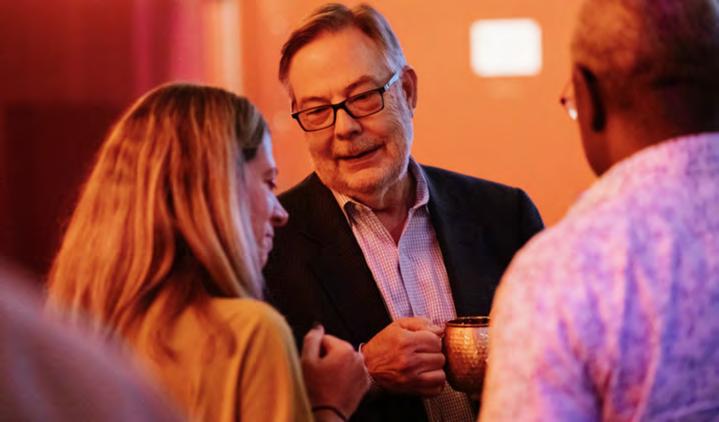
BERKLEE BOSTON
ESIN AYDINGOZ is the new assistant chair of the Screen Scoring Department.
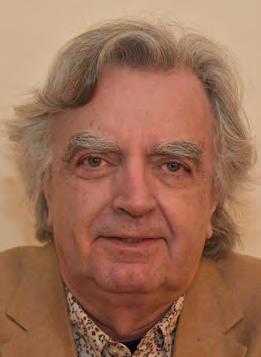
1 Professor LARRY BELL completed two CDs for release in the fall. The first, Thoughts and Prayers, was the result of a faculty recording grant. The second is the double CD Twenty-Four Preludes and Fugues. One of the four pianists on this recording is Professor JENNIFER ELOWSKY-FOX
Associate Professor SERGIO BELLOTTI is a new member of the Recording Academy and joins the countless creators and professionals who serve, celebrate, and advocate for our music community year-round.
Associate Professor CATHERINE BENT did a concert tour in São Paulo, Brazil, and gave workshops entitled “Tem violoncelo no choro.” She also delivered shows in Brasília with Berklee student Ian Coury. In Rio de Janeiro, she performed with Choro na Rua and other local groups.
RHODA BERNARD, assistant chair of the Music Education Department, will deliver keynote addresses on arts education and students with disabilities this fall at conferences in Kentucky, Washington, and Nebraska. She is also leading workshops at the LEAD and Arts Schools Network conferences, and at numerous school districts and arts organizations.
MICHAEL BIERYLO , chair of the Electronic Production and Design Department, authored the chapter “The Electronic Digital Instrument: What Does It Mean to Develop Musical Skill with a Computer?” in the book Commercial and Popular Music in Higher Education. Visit tinyurl. com/ya7axfte.
AMPARO EDO BIOL, chair of the Contemporary Writing and Production Department, was named composer in residence at the Spanish Brass Festival Alzira, where her newly commissioned composition for brass quintet, Barandat, was premiered.
Professor JOANNE BRACKEEN was interviewed for the JazzTimes article “Before and After” in its October issue. She was also interviewed by Isabelle Leymarie for an upcoming book on jazz artists.
Professor FREDDIE BRYANT received the Chamber Music America New Jazz Works grant in 2019. Due to COVID, his work, Upper West Side Love Story, premiered this year. It features 16 songs and documents the history, change, and gentrification of the historic neighborhood he grew up in. Visit upperwestsidelovestory.com.
RICHARD CARRICK, chair of the Composition Department, was a
visiting professor at the Jerusalem Academy of Music and Dance, offering master classes as well as lectures on his works for dance, improvisers, and graphic scores. Carrick premiered three new works for piano there. His work Nadia Boulanger also premiered in New York City.
Assistant Professor CRISTI CATT traveled to Fayetteville, Arkansas, in July to perform with Blue Thread, a group she cofounded to explore ballad migration and shared stories. The group’s concerts wove together Hindustani, Carnatic, Portuguese, Sephardic, Slavic, Celtic, and American song traditions and were made possible by the Walton Family Foundation.

1 Assistant Professor ORLANDO CELA released an album, Miniature Symphonies, featuring new works by Yoko Nakatani, Brittney Benton, Quinn Mason, and Kevin Scott that were commissioned for the project.
Assistant Professor ERIC CORNELL premiered Anne of Green Gables: A New Musical. He is the lead producer of its commercial production and has been developing the show at Goodspeed Musicals in Connecticut. He is also general manager for a two-year international tour of The Sound of Music.
KRIS DAVIS, associate program
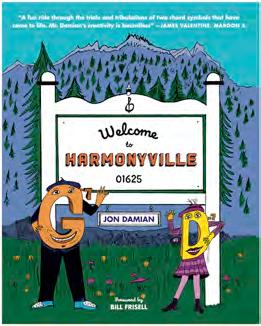
1 Professor Emeritus JON DAMIAN released Welcome to Harmonyville 01625. The graphic novel is about a good-natured town whose residents are chord symbols, and is infused with life by Damian’s illustrations and narrative.
director of creative development for the Berklee Institute of Jazz and Gender Justice, was named pianist of the year in the 2022 DownBeat Critics Poll. She also won the North Sea Jazz Festival Paul Acket Award this year.
Professor BOB DOEZEMA received the Professional Writing and Music Technology Division’s Lifetime Achievement Award in recognition of his powerful impact on many generations of students, his contributions to Berklee’s curriculum, his mentorship to fellow faculty, and his deep musicianship. Doezema retired from Berklee this spring after 46 years of service.
Professor JAN DONLEY’s art was chosen to be featured at the Jamaica Plain branch of the Boston Public Library.
Associate Professor DEREK FAWCETT performed release shows for “Runnin’ Outta Somedays”
and “Sticks & Stones” at Rockwood Music Hall, and presented at the Association for Popular Music Education in Detroit. Visit linktr.ee/derekfawcett.
Professor TOMO FUJITA started writing a monthly two-page column in Guitar Magazine (Rittor Music in Japan). He also posts related videos on YouTube, is working on a new album, and appeared at a showcase in Nashville. Visit tomojustfunky. com.
5 Professor LASZLO GARDONY released an album with guitarist Kevin Kastning. Gardony’s album with Associate Professor JOHN LOCKWOOD and Percussion Department Chair YORON ISRAEL, Close Connection, will be released in December. They will perform on December 8 at Birdland Jazz Club, and on January 26 at David Friend Recital Hall.
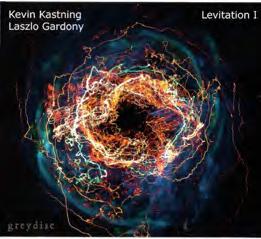
Professor BRUCE GERTZ won an award for “Song for Crumbles’’ in the International Songwriting Competition’s Cut the Chord category. A contributing editor for, and advisory board member of, the International Society of Bassists, he wrote articles about Steve Swallow and Ron Carter. He also released his 21st album, Gently Said.
Professor RICH GREENBLATT visited Ghana for three weeks to play the music of the Ewe, Ashanti, Ga, and
Intervals —
BY ALLEN BARGFREDE

Formidable outside forces, such as the birth of a new technology, can forever alter arts and culture in our world. The advent of digital technology has caused a dramatic paradigm shift in the control and delivery of music that is still being defined. Entire catalogs of content are now traded more quickly than a register could ring up a sale at a record store.
Gaps in copyright (the law that protects artistic works and allows creators to control the exploitation of their works) continue to emerge, and courts are left to apply decades-old law to unanticipated situations arising from this new digital landscape. New copyright legislation is often introduced around the world, but as stakeholders lobby to maintain the status quo, significant change
rarely occurs. (The 2018 Music Modernization Act and 2019 E.U. Copyright Directive seem to be exceptions rather than the norm.)
One thing remains clear, however: Music consumption has never been higher. With music surrounding us in television, film, video games, and satellite radio, and the ability to listen to nearly 100 million songs in our pocket, we listen to more music than ever. This means that musicians must be more careful than ever about understanding their rights and metadata.
Because copyright, revenue collection, and metadata can be overwhelming for creators, who often prefer to focus on their art, I have prepared short checklists for all artists and songwriters to keep in mind when preparing to release their music:
If you are an artist, here are few things to keep in mind:
p Register your sound recording copyrights at copyright.gov.
p Be sure to have assignment of copyright interest from any producers, hired studio musicians, or others who worked on your album.
p Join a performing rights organization (PRO) to collect performance royalties on public performances of your work(s).
p Make sure you have mechanical licenses in place for any songs you didn’t write.
p Clear licenses with publishers and labels for any sampling.
p For distribution of your music online, distributors such as CD Baby, TuneCore, and the Orchard offer the ability to get your music onto services such as Spotify and Apple Music without a record label.
p Join SoundExchange to receive royalties from digital performances.
p Check into collecting your neighboring-rights monies from overseas.
p Stay on top of any agreements you enter into with labels, promoters, etc. Be aware of termination dates, promotional commitments, your right to leave a label, etc.
Songwriters also have their share of work to do to ensure they are protected and can earn money from their musical compositions via recording and public performances. If you are a songwriter, here are few things to keep in mind:
p If you cowrote a song, be sure to talk to your cowriters about the split of copyright ownership, and set it forth in writing.
p Register your musical composition copyrights at copyright.gov.
p Join a PRO, and set up both writer and, if you do not have a publisher, publisher accounts. (Each will be entitled to 50 percent of your income and paid out separately.)
p Register with the Mechanical Licensing Collective (MLC) to collect mechanical royalties in the U.S.
Dagara peoples of West Africa.
Assistant Professor BENNY GROTTO was the producer and recording engineer for a Death Ray Vision album on Metal Blade Records. The band is a side project of Mike D’Antonio from Killswitch Engage. Grotto is also the drummer in Associate Professor HAYLEY THOMPSON-KING ’s band.
Assistant Professor SUSAN HAGEN has recorded and/or performed 99 pieces, including 50 premieres, since March 2020. Most of the pieces were for solo double bass. She has given eight solo recitals online that have raised over $3,000 for charity.
DARLA HANLEY , dean of the Professional Education Division, joined the Arts Schools Network (ASN) Board of Directors, and presented her book Jazz Is Elementary at the ASN conference. She’s also invited to present the book at the Jazz Education Network Conference, the Virginia Music Educators Association Conference, and at California State University, Northridge.
Associate Professor DAVID HARRIS joined the Boston Modern Orchestra Project as jazz trombone soloist for the opera X: The Life and Times of Malcolm X, by Pulitzer Prize–winning composer Anthony Davis. Following a performance at the historic Strand Theatre, the orchestra recorded the work, which will be released in 2023.
Professor GAYE TOLAN HATFIELD won a 2022 Daytime Emmy Award in the Outstanding Original Song category for “Grateful for It All,” cowritten by Associate Professor BRAD HATFIELD and Jeff Meegan.
Assistant Professor RALPH JACCODINE was voted into the Record-
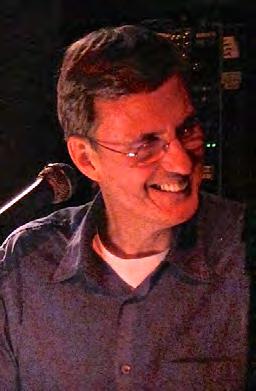
1 Assistant Professor STEVE HECK recently finished the 14-track country-influenced pop album Midwest Memories. The album’s band includes professors CASEY SCHEUERELL, JOE SANTERRE, and NORM ZOCHER; Associate Professor BOB PATTON ; and faculty member MIKE DUKE. The project started in 2002.
ing Academy as a professional member of the academy’s Philadelphia branch, which is close to his hometown of Allentown, PA, where he was a musician and concert promoter.
Assistant Professor ANDREW JARBOE’s book Indian Soldiers in World War I (University of Nebraska Press) won third place in the Society for Army Historical Research (SAHR) Templer Best First Book Prize competition at the National Army Museum in London.
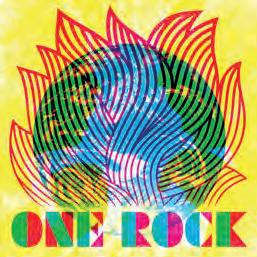
1 Associate Professor MATT JENSON is a member of the band Groundation, which released the album One Rock. The band did a five-week European tour and will tour again this fall. Visit groundation.com. Jenson is also developing his online educational platform, Art of Reggae. Visit
artofreggae.com.
Professor JIMMY KACHULIS ’s concert pieces have received prizes in various competitions, including the TUTTI Festival in 2022 and the International Trombone Festival in 2019, 2021, and 2022. His work has also been performed by the Veridian String Quartet, the Odin Quartet, Azimuth Orchestra, the Boston New Music Initiative, and more.
Professor JIM KELLY taught at the Berklee clinics at the Umbria Jazz Festival in Perugia, Italy. This is the 35th anniversary of Berklee’s involvement; Kelly took part in the first Berklee event there and has taught at the festival more than 25 times.
Associate Professor BRUCE KILSTEIN’s short story “The Recipe for Making Blood” was published in the spring issue of Blackbird magazine. Visit blackbird.vcu. edu/v21n1.
HAE JOO KIM, assistant chair of the Professional Music Department, was a panelist on “From K-Pop to K-Explosion: Lessons from Korea’s Creative Economy” at the Milken Institute Global Conference 2022.
Assistant Professor JULIE KINSCHECK released a new book, Vocal Training for Praise Singers. She exhibited at the World Discipleship Summit in Orlando and presented at the Worship Innovators Conference in Chicago. She also led the first New Voice Faculty Improv Spotlight concert at Berklee. Visit julieksings.com.
Professor TEODROS KIROS wrote two books, Self-Definition: A Philosophical Inquiry from the Global South and Global North and Conversations with Cornel West, as well as a review of George Yancy in Black Studies
and a review of Charles Mills on race in the CLR James Journal
Associate Professor ERICA KNOWLES and her team from the Berklee Psychology of Music Research Lab presented their study “Auditory Statistical Learning in Classical and Jazz Musicians” at the 2022 conference of the Society for Music Perception and Cognition.
Professor BARBARA LAFITTE was the chamber music librarian at the Aaron Copland Library at Tanglewood Music Center for its summer program. In addition to fulfilling her responsibilities to her 12- and five-week students at Berklee, she prepared chamber music for the TMC fellows, meeting musicians from around the world.

1 Professor LORI LANDAY is a visiting fellow at the MIT Open Documentary Lab during her sabbatical leave this academic year. Her project, Moving Realities: Capturing and Creating Motion and Emotion in Interactive 3D Environments, will produce virtual and augmented reality experiences accessible on the web.
Assistant Professor STEVE LANGONE performed concerts with the Boston Pops and the Boston Pops Esplanade Orchestra; toured with Greg Piccolo and
BY KEVIN HARRIS

For many people who have grown up in and around Pan-African–influenced culture— especially the Black gospel experience in the U.S.—it’s not uncommon to see and hear churchgoers playing and singing with the vocal ability of Aretha Franklin or Sam Cooke, or possessing the groove prowess of Robert Glasper.
In many of these congregational settings, the music often flows so naturally that church members sing, sway, dance, shout, and move because it is simply part of the cultural experience—to participate. It’s as if you’re witnessing the inspiration for the musical styles born here in America and exported across the globe, such as blues, R&B, jazz, and the pop-rock that gave rise to J-pop, C-pop, and K-pop. So what happens when educational institutions begin to implement the tenets of this cultural phenomenon? My advanced piano course, in which I teach the African-Influenced Method (aim), seeks to answer this question.
aim doesn’t abandon the Pythagorean-influenced understanding of music (i.e., analysis/writing), but it prioritizes a more humanistic foundation based on a Pan-African perspective. The method facilitates an understanding of music through soulfully syncopated movement (dancing, singing, clapping, snapping, or using vocal sounds), creating a symbiosis between tradition-
al ways of learning music and the informal methods of learning found in Pan-African–influenced culture.
Interestingly enough, millions of 5-yearold children master the seemingly impossible every year: verbal communication. This isn’t accomplished because they are given the best books or expensive tutors, or because they have high iq levels. They (and many adults) are simply immersed in the language and thus rise to the expectations of those around them. Why shouldn’t the same unquestionably successful method be applied to playing music, and be taught at music education institutions where Pan-African music is championed?
Three steps help internalize aim: Grammar (dissecting the musical vocabulary), movement (moving to a musical idea before touching the instrument), and immersion (playing ideas in a nonstop structured setting emulating and expanding the first learned concepts).
Applying aim, we abandon academic assessment and instead prioritize the cultural mode of learning that has been present in the Pan-African musical tradition since time immemorial. While this method has been second class to many institutional modes of learning, it continues to be a wellspring that inspires many of the most recognized musical styles around the globe. Instead of
teaching our minds to acquire and regurgitate information according to traditional academic standards and assessment, this method endeavors to unite mind and body to symbiotically improve the individual as a musician and as an artistic thinker.
In July I traveled to Morocco and was invited to sit in with a group of Amazigh drummers. Before we played, I compulsively inquired about the name and history of the syncopated pattern the drummers were playing. Yassin, a drummer to my left, looked at me, smiled, and said, “Just play.” Him saying this was an eye-opening reminder of how I first internalized music as a child, when music was joyfully experienced first, and the labels, analysis, and judgment of that music came much later.
An essential component of internalizing musical ideas in aim is to physically participate in that music. In many Pan-African–influenced cultures, dance and music are symbiotic. The overlapping of sound and movement is foundational and a way to connect deeply with music. At the heart of this priority is a profound pedagogical paradigm shift that will augment existing systems of learning and more holistically shape musicians. Preparing students to navigate the real-world demands of performance is no task task. aim might be the catalyst that encourages musicians to “just play.”
Heavy Juice; and released new works with Professor Claudio Ragazzi, Shawnn Monteiro, Marc Albanese, and Andrés Enrique.
Assistant Professor CLAIRE MARIE LIM presented at the Audio Engineering Society’s 152nd convention, sharing a paper she wrote about grid performance controllers and hardware in live electronic music performance. This event was made possible through a partnership with the Royal Conservatoire of The Hague.
Professor NANCY MARSHALL released the new album Sing Prais-
5 Assistant Professor MING YUAN LOW finished his first year of teaching full-time in the Music Therapy Department. This summer, he competed in the Club Crew World Championships in Florida with his old team, Pennsylvania Dragon Boat Club, and is on the Boston 1 Dragon Boat Team.

es!, coproduced with Rob Rose, former vice president of special programs.
Associate Professor NANDO MICHELIN released the album Letters from the Quarantine, featuring Berklee alumni, and is working on a new album, The Magical Universe of Eduardo Mateo, featuring Uruguayan musicians. All proceeds from this album will go toward treatment for mental health and autism in Uruguay.
Professor JANE MILLER, director of Berklee’s Guitar Sessions summer program, authored an article in the September/October issue of Acoustic Guitar magazine. The music library Mpath Music is releasing an EP of her compositions for media.
Associate Professor AMANDA MONACO performed at the Rochester International Jazz Festival with her all-female sextet, Lioness, in June.
Professor TIGER OKOSHI was an artistic director for the Youth Jam Session, created by the Sapporo Art Park organization, in Hokkaido, Japan.
Assistant Professor VALERIE ORTH received a Berklee Faculty Fellowship for her work with Palestine Beats, an educational program in the West Bank that she helped create. It combines songwriting, music technology, and nonviolent communication.
Professor LAUREN PASSARELLI released the original EP The Highest Moon and collaborated with Kate Chadbourne on their album Book of Your Heart, which features guest artists Mike Bishop, LEAH BLUESTEIN B.M. ’20, Mary Ramsey Douyard, and Professor

1 Associate Professor YOKO MIWA was nominated for a Rising Star award for piano in the 2022 DownBeat Critics Poll, and performed at Dizzy’s Club at Lincoln Center with her trio.
Professor MARCELLO PELLITTERI performed in Europe with New York Voices, with the legendary Brazilian guitarist Toninho Horta, and with his own Elektric Eclectic Band, which includes FRANCESCO GUAIANA B.M. ’01 .
Associate Professor LUIS PERDOMO is featured on recordings of Music of the Americas by saxophonist MIGUEL ZENÓN B.M. ’98 , and on trumpet master Tom Harrell’s album Oak Tree. In addition, he performed with his trio at the Zinc Bar in New York City in August.
MARCO PIGNATARO, managing director for the Berklee Global Jazz Institute, was the musical director for JazzBoston’s
JazzNow recording series and for the Swedish Tallberg Foundation recording for climate change advocacy. He released a record in April, Marco Pignataro’s Dream Alliance’s Awakening, and one in September, Chant for the Planet.
Assistant Professor KAORUKO PILKINGTON earned a Master of Music degree (jazz performance concentration) from New England Conservatory (NEC). During her study, she sang as one of the featured vocalists with visiting artist Cécile McLorin Salvant, and her composition “Cherry Blossom Trees” was performed by NEC Artist in Residence Dave Holland’s ensemble.
Professor ALISON PLANTE scored the feature documentary As Prescribed, which premiered this
BY MICHAEL BLANDING
Every year in his Intro to Music Business class, George Howard asks students how many believe that if they signed with a major label, the contract would be fair. “No hands show,” he says. Then, he asks students how many of them would sign a deal if an A&R person from a major label walked into the room and offered one. “And 80 percent of hands in the room go up,” says Howard. “It just shows me that they don’t like their options, but they don’t know what the others are.”
Howard, a professor of music business, has spent his career trying to change that. “My purpose is to help musicians create and maintain successful careers on their own terms,” he says. “I’ve been tilting at that windmill since I started putting out records from my college dorm room.” Often, that has meant employing new technological innovations to change the terms of engagement. Last December, Newsweek named him one of “America’s 50 greatest disruptors.”
In the late 1990s, he was president of Rykodisc, then the first CD-only independent record label; in the early 2000s, he cofounded TuneCore to license music over the web. His latest ventures employ blockchains, decentralized and encrypted computer databases, to increase transparency for artists and help them monetize their works and connect directly with their fans. “My analogy is that licensing music in 2022 is like booking travel in 1975—it’s full of intermediaries,” says Howard, author of Everything in Its Right Place: How Blockchain Technology Will Lead to a More Transparent Music Industry. “Artists don’t really have any control.” The way contracts are set up on streaming platforms such as Spotify and Amazon Music, some big-name artists make lots of money while the majority of artists make little—and the labels sit back and rake in the passive income.
Howard created a licensing platform for student musicians at Berklee called raidar (Rights and Asset Information in Decentralized, Authoritative Repositories), using a carbon-neutral blockchain called Algorand. Once information is put onto a blockchain, it cannot be removed, creating an accurate record of ownership; in addition, a blockchain can employ “smart contracts” that automatically process transactions according to set rules. “A student can set the
price and terms for a song, and so long as a buyer agrees to it, the contract will unlock,” Howard explains. The platform will allow students to directly license their content for student films, video games, and other projects.
Howard is now working on broadening this licensing arrangement to a commercial platform called Dequency, which would be open to any artist. In another project, the Song That Owns Itself (stoi), artists distribute ownership tokens for a song to fans, who sell and distribute these tokens and split the profit. A blockchain keeps track of transactions, so artists can get to know their most loyal fans and reward them with perks such as advance concert ticket sales or “Ask Me Anything” sessions with the band. Already, the project has worked with such artists as Superposition and Darryl “dmc ” McDaniels
(of Run-dmc fame).
Howard develops and invests in these ventures while at the same time teaching classes at Berklee such Music + the Blockchain, hoping he can inspire students to become music entrepreneurs themselves.
“I’m proud to be part of an institution that allows me flexibility to try something at a time when most other academic institutions would be like, ‘Well, we don’t know what this is; we’re going to stay away from it,’” he says. Ultimately, he hopes blockchain technology will catch on in the music-licensing industry more broadly, so everyone will be more accurately and justly compensated. “But especially independent artists,” he says. “It’s to them my heart is obviously biased.”
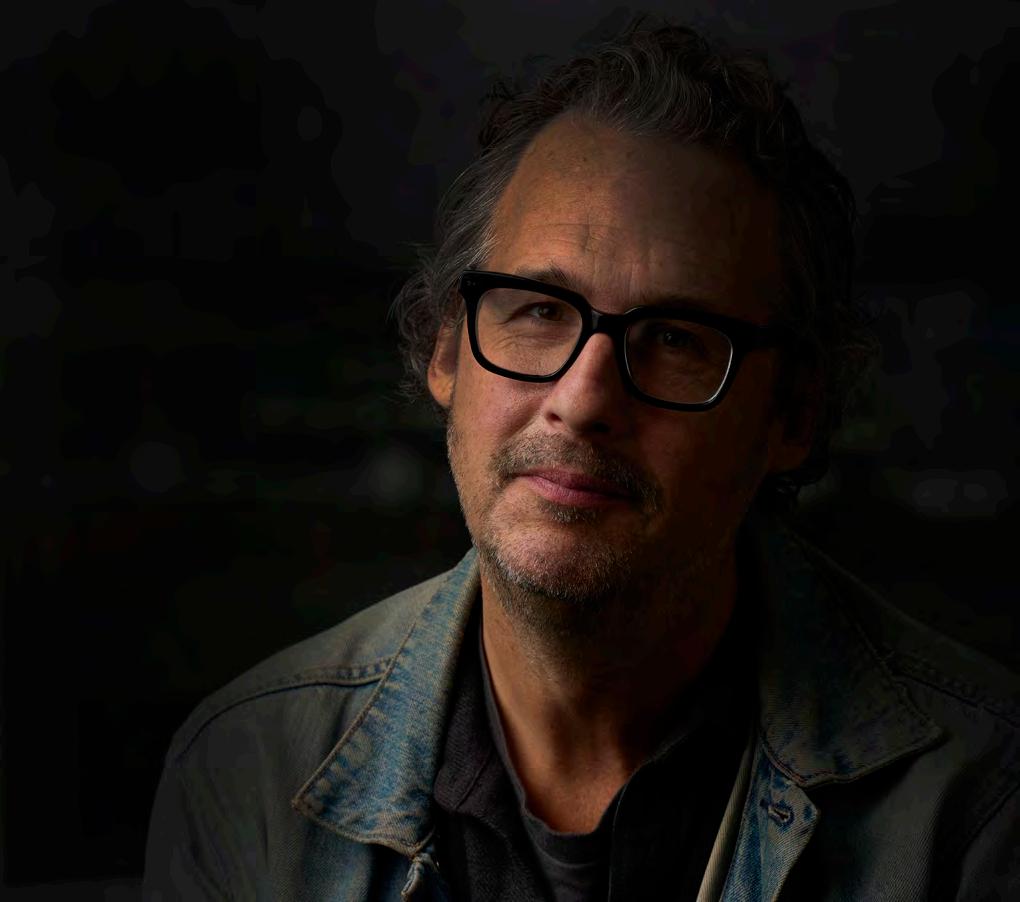
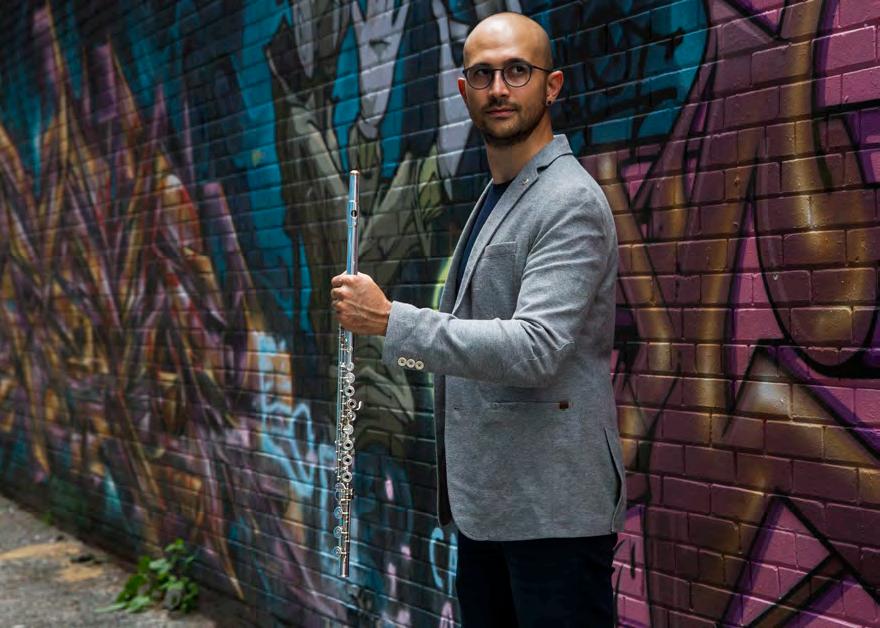
1 Instructor SARPAY ÖZÇAĞATAY published six method books for flute and C instruments in recent years: the five-volume UNLOCK series, and JAZZ LICKS Comprehensive Studies for Flute & C Instruments. The first volume of his UNLOCK series is the best-selling flute book in its category on BookAuthority.
summer at the Berkshire International Film Festival and had its international premiere at Sheffield DocFest.
Professor RON REID was awarded the Caribbean Foundation of Boston’s Martin Luther King Award for his contributions to the development of the steelpan at Berklee and in the city of Boston. In August, he performed with the Caribbean jazz ensemble Caribbo, which includes Berklee alumni. Visit caribbomusic.com.
Professor NED ROSENBLATT directed the Berklee Advanced Vocal Jazz Ensemble, which won its second consecutive DownBeat Student Music Award in the undergraduate ensemble category. The ensemble has also been selected to perform at the 2023 JEN annual conference in Orlando.
Assistant Professor COLLIN RUSSELL was an editor of, and contributing writer for, the book Synth Gems 1 by Mike Metlay, and a contributing writer for the book Inspire the Music: 50 Years of Roland History by Kim Bjørn. Both works were released this year. He also scored a short horror film, Paracosm.
Professor JOE SANTERRE performed on three albums: Just Passing Thru by jazz/fusion multi-instrumentalist Miles Donahue; Tribute, a tribute to Bonnie Raitt by Jon and Juli Finn; and Through the Noise, by pop composers Lisa and Brett Brumby.
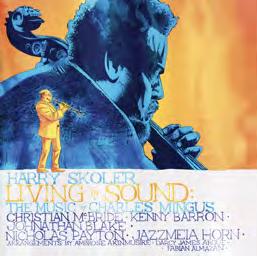
1 Professor HARRY SKOLER released Living in Sound: The Music of Charles Mingus, featuring Christian McBride, Kenny Barron, and others, and with arrangements by Fabian Almazan, Ambrose Akinmusire, and others. The record charted for jazz radio airplay, according to JazzWeek. Skoler was also featured in articles about Mingus in Jazziz and JazzTimes
Professor ROBIN STONE played four solos on her friend Nico Pitzer’s latest album, Blue Clouds, which was released in June.
Associate Professor NICHOLAS URIE arranged “Sweet Isolation,” a recording by the Metropole Orkest featuring Oscar Jerome. Urie also arranged a track on the upcoming Warner Classics release by Lucienne Renaudin Vary. Visit nicholasurie.com.
Associate Professor DAVID VALDES’s novel Spin Me Right Round is on the New York Public Library’s Best Books for Teens list and was an Indie Next List pick and Junior Library Guild selection. His novel Brighter than the Moon will appear in January.
Instructor CARLOS VARGAS ’s debut tour in Germany included performances at the premiere of the Steinway & Sons Black Masterpiece collection in Hamburg and a solo recital at Musiken Kirchheimbolanden. His playing was described by the German press as being filled with “striking energy and uncompromising honesty.”
Professor MARK WALKER graduat-
ed with a master’s degree in jazz composition from the University of Massachusetts Amherst and was offered a gig with Arturo Sandoval touring the U.S., Europe, and South America. Walker also recently headlined at the Arlington Jazz Festival with his group and worked with the Boston Pops.
The second edition of VICTOR WALLIS’s book Red-Green Revolution: The Politics and Technology of Ecosocialism, from Political Animal Press, was released in August.
LATE, a musical confronting school shootings, with music by Professor MICHAEL WARTOFSKY and text by Kathleen Cahill, was presented at the Boston’s Calderwood Pavilion in Moonbox Productions’ Boston New Works Festival.
KENNY WERNER, artistic director of the Effortless Mastery Institute, did a four-week tour in Europe, including three weeks with the Metropole Orkest, featuring Grégoire Maret on harmonica,
5 Professor SUZANNA SIFTER wrote a new book, A Modern Method for Piano Scales, which is the partner book for her new Berklee Online course, Scales 101, which went live this summer.
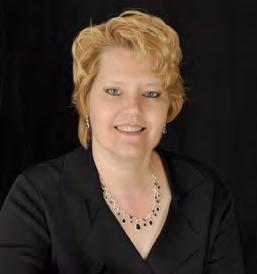

1 Professor DIDI STEWART wrote a new musical, An Infinity of Stars, which features a 20-song score and an original script about the political divisions tearing our country apart. The debut performance featured a stellar cast of Berklee faculty. A cast album is forthcoming, courtesy of a Berklee grant.
celebrating Toots Thielemans’s 100th birthday. Werner’s notebook, Becoming the Instrument: Lessons in Self-Mastery from Music to Life, was also released.
Associate Professor KIRSTIE WHEELER sang with the Tanglewood Festival Chorus, in late August performances of Beethoven, Borodin, Ives, and Shostakovich, after two and a half years of hiatus due to COVID.
Professor JULIUS P. WILLIAMS’s orchestra version of his work Those Heroes Who Healed the Nation was premiered at the Boston Pops’ July 4 spectacular. It was first commissioned as a chamber ensemble piece for the June rededication ceremony for the restored
Robert Gould Shaw and Massachusetts 54th Regiment Memorial. Associate Professor KEVIN WILSON and Assistant Professor LORI L’ITALIEN (Conservatory) presented “Teaching Musical Theatre Voice” at the National Association for Teachers of Singing conference in Chicago. Wilson will present “Teaching Musical Theatre: Using Emotion to Stimulate Filter Change” at the Pan European Voice Conference in Tallinn, Estonia.
BOSTON CONSERVATORY AT BERKLEE
Associate Professor JEAN ANDERSON published an e-book, The Young Classical Singer’s Toolbox, available on Amazon; taught this summer at CANTO, an opera training program for young singers; did a residency in October at the University of Connecticut; and is the pianist for Boston Opera Collaborative’s song cycle “Love in the Time Of...”
Associate Professor CANDICE
BROWN received a faculty innovation grant for voice and speech curriculum development. She has also been a vocal or dialect coach for the Gamm Theatre’s productions of A Midsummer Night’s Dream, Ironbound, and An Octoroon.
Assistant Professor JESSYE DESILVA released their album Landscapes. It received critical acclaim in No Depression magazine, which called the album “a tour de force of queer country music.”
JERMAINE HILL , assistant chair of the Theater Division at the Conservatory, served as music director and arranger for Steppenwolf Theatre Company’s critically acclaimed production of Choir
Boy, written by ensemble member and Academy Award winner Tarell Alvin McCraney.
Professor RHONDA RIDER celebrated 20 years of directing the Cello Seminar at Music from Salem, in New York. She also performed and taught at the Harvard and Green Mountain chamber music festivals.
Associate Professor ANGELA FARR SCHILLER dramaturged the West Coast premiere of Dominique Morisseau’s play Confederates, directed by Nataki Garrett at the Oregon Shakespeare Festival. It asks the question, “What does Black, female-identifying liberation look like in our current historical moment?” Visit osfashland.org/produc-
tions/2022-plays/confederates.
Associate Professor ELIZABETH WONG directed The Children, by Lucy Kirkwood, at the 2022 Fairhaven Summer Repertory Theatre in Bellingham, Washington. Wong’s commissioned play, an eco-comedy called Space Nuns of the Rescue Mainframe, is premiering this fall at the Hook & Eye Theater in Brooklyn.
BERKLEE VALENCIA
Associate Professor ENRIQUE HERNANDIS was an invited composer at the National Gugak Center in Seoul, South Korea. He wrote a piece for daegeum, haegeum, and gayageum titled “SOLEA,” which mixies flamenco and traditional Korean forms of music.



1971
KENNETH GABRIEL HEISER B.M. of Laredo, TX, held a concert featuring a six-piece band playing 20 of his original songs in his hometown of San Miguel de Allende, Mexico.
1973
KEVIN DRISCOLL B.M. of Framingham, MA, led the performance of the Driscoll Productions Brass Band Concert, honoring a Boston-area Marine veteran’s 100th birthday. The band used a Dixieland-style marching entrance, playing tunes such as “The Marine’s Hymn” and “When the Saints Go Marching In.”
FAITH JONES OZAN of Crestline, CA, moved from Laguna Beach to Los Angeles, where he built a specialized music cottage to provide music lessons for students with autism. Individualized programs address speech, language, behavioral, academic, and social goals within musical environments.
1977
MICHAEL DRUXMAN of Corrales, NM, played bass with the Albuquerque Philharmonic Orchestra. A recent concert included Beethoven No. 3 (“Eroica”) and John Williams’s Harry Potter Symphonic Suite. Druxman also performs with his jazz quartet Last Call and has won awards from the New Mexico Activities Association for his original compositions.
STEVEN SALTZMAN released his second book, The Music of Film: Collaborations and Conversations, this summer. Through interviews and conversations with professional composers, music supervisors, music editors, and

1 TIM SUBLETTE ’79 of Smithville, MO, released his tablaturebased method book, Necessary Guitar, in April; it is available on Amazon. Sublette is also the owner of Smithville Music Studio in Smithville.
picture editors, the book shows how music for film and television works, according to insiders in the industry. Visit saltzmanmusic.com.
1978
DAVID WILSON B.M. of Orange, NH, retired from a 40-year teaching career in 2020. He has spent his retirement writing the book, music, and lyrics for a twoact musical entitled Freedom Lost. He is beginning to promote the show through his production company Orange Wind Productions.
1980
SIRABHORN TI MUNTARBHORN B.M. of North Hollywood, CA, recently gave a master class titled This Business of Music to a select group of jazz music graduate and undergraduate students from Royal Conservatoire The Hague. The class was videotaped for the conservatory’s archives.
1981
PHIL RASKIN B.M. of West Orange, NJ, is a drummer, percussionist, and producer whose career has spanned more than four decades and has taken him to over 30 countries. He has performed with many acclaimed artists, including MIKE GIBBS ‘63 and faculty members JOE LOVANO and GEORGE GARZONE, among others. DAVID ROSENTHAL B.M. of West
Windsor, NJ, is currently the musical director and a keyboardist for Billy Joel.
ROLF STURM of North Bergen, NJ, has collaborated with renowned jazz performer Abbey Lincoln and vocalist/songwriter Jenna Mammina for nearly a decade. He recently performed at Dizzy’s Club at Lincoln Center and 10 Columbus Circle in New York City.
1982
PETER MUNSCH B.M. of Pound Ridge, NY, released the album Primal Impressions this spring with the help of his Munsch Bunch. The songs were inspired by life experiences, fellow musicians, family elders, a Greek poet, two Clydes (Stubblefield and Frazier), Sister Rosetta Tharpe, and Biblical verses.
BOB ROSS B.M. of New York City is
5 LENORA HELM HAMMONDS B.M. ’82 of Durham, NC, received a doctoral degree in music education in September. She also completed a film score for the indie film The Problem of the Hero.

Pianist Dayramir Gonz ález blends culture and experience to create his own style. BY
NICK BALKIN
It was only his first semester at Berklee, and DAYRAMIR GONZÁLEZ
B.M. ’13 was already overwhelmed. The Cuban piano prodigy was rehearsing in an ensemble made up of the school’s top players, who were taking turns improvising over the jazz standard “All the Things You Are,” when the ensemble director threw them a curveball: Each time through the chord progression, the band had to shift the song’s key up a half-step.
“I was so stressed,” González said. “I kept thinking, ‘Man, after they get done playing, it’s coming for me.’ I remember the bass player doing all this advanced stuff and I was like, ‘Bro, just play the freaking roots!’”
Despite arriving at Berklee at age 26 with a résumé that almost
any jazz musician would envy, González, like many international students, struggled with the transition to a new culture and learning environment. “There was a language barrier,” he said. “I was an accomplished Cuban pianist, but I felt naked in terms of the American jazz vocabulary.”
Born and raised in the working-class Havana neighborhood of El Cerro, González grew up during Cuba’s Special Period, an era marked by economic turmoil. There were times that his family didn’t have electricity, but music was never in short supply. His father, Fabian, was an Afro-Cuban jazz trumpeter, and musicians were constantly dropping by the house for impromptu jam sessions.
He discovered the
Alumni Spotlight
Dayramir González

piano at age 7, excelled quickly, and was later accepted to Cuba’s renowned National Art School. In his first year there, he met Oscar Valdés, a musician from the Grammy-winning band Irakere, who recruited González for his then-new group, Diákara. That led to a six-year stint playing in Giraldo Piloto’s timba band Klímax. In 2007, González released his first solo album, Dayramir & Habana Entrance, which won three Cubadisco Awards, the Cuban equivalent to a Grammy Award. In 2008, Chucho Valdés, the “dean of Latin jazz,” invited González to open the Havana Jazz Festival.
A year later, just as his career was starting to take off, González flew to Mexico City to audition for Berklee. “I had a desire to express myself more freely,” he said. “I knew that I was talented but going to Berklee seemed so untouchable. So I said, ‘Let’s see what happens.’” A few weeks later, he received Berklee’s coveted Presidential Scholarship, becoming the first Cuban to do so.
At Berklee, he broke out of his comfort zone, gaining structure as a composer and arranger while dramatically expanding his jazz vocabulary. “[I learned how] to target what kind of emotions—what kind of colors—I can use to impact the audience and
make them feel the way I want them to feel,” he said. After graduating, González began channeling these skills into what would become The Grand Concourse, his triumphant 72-minute second album.
“I’d say 70 percent of that album was created at Berklee in a class that had a major impact on me called Advanced Modal Harmony,” he said. “I remember the teacher, Joseph Mulholland, saying, ‘Man, I’m loving these compositions so much that if you ever record an album with these songs, please send it to me.’ So I did.” González hasn’t slowed down since. His group, Dayramir González & Habana enTRANCé, tied for first place at the 2021 DCJazzPrix. His latest recording, A Tribute to Juan Formell and Los Van Van, was released last fall, and he has two more on the way: Vida, a quartet album in which the piano is the “main character,” and Mozart Meets Havana, which imagines what Mozart would sound like if he were Black, Cuban, and living in New York City.
“It combines my Cubaness, my West African influences, my Berklee knowledge, and my European conservatory background,” said González. “That’s who I am.”

1 MICHAEL J. RIVARD B.M. ’85 of Waltham, MA, produced, composed, arranged, and played bass and Moroccan sintir on the Club d’Elf album You Never Know, which features Professor DAVID FIUCZYNSKI, Assistant Professor PHIL GRENADIER , and DEAN JOHNSTON B.M. ‘91. He also recorded bass for Natalie Merchant’s upcoming album.
a bassist and is currently recording a new album with his improvisational soundscape trio, RMA.
GARY STAGER B.M. of Torrance, CA, launched Cymbal Press to gather the voices of artists for the world to hear. Cymbal Press’s first book, Life in E Flat: The Autobiography of Phil Woods, was named the 2021 Jazz Book of the Year by the Jazz Journalists Association.
1983
JOHN G. WILLIS of Scottsdale, AZ, has released his first full-length album of original material, Kinda Love, which streams on all major services. The album, which was released in June, features
11 tracks composed during the COVID shutdown. Visit johngwillis.com/kinda-love.
1985
DAVID BONDELEVITCH B.M. of Denver, CO, was elected to the Board of Governors of the San Francisco chapter for the Recording Academy. He has been teaching for 14 years at University of Colorado Denver, where he is an associate professor of music.
MARISA T. DÉRY B.M. of Somerville, MA, engineered the restoration of the audio tracks for My Life with the Chimpanzees and The Hope.
Additionally, as chair of the Audio Engineering Society, she published the paper “AES Standard for Audio Forensics—Speech Collection Guidelines for Speaker Recognition: Interviewing at a Temporary Location.”
SUSAN BOTTI B.M. of Red Hook, NY, released Mangetsu (on the New Focus label) by Della Luna, her duo with violinist Airi Yoshioka. The album features Botti’s compositions and arrangements. Botti also recently received a Fromm Commission for her theatrical chamber motet River Spirits, which premieres this fall.
ARUL KARTTIKEYA B.M. of Princeton, NJ, was interviewed by Doug Fearn for the podcast My Take on Music Recording. Karttikeya discusses his 15 years of audio work with Music Together Worldwide; his own project, Turiya; and his musical journey, including his time at Berklee. Visit buzzsprout. com/942952/10444774.
5 ANDERS BOSTROM B.M. ’90 of Verona, NJ, plays 16 bamboo flutes in the premiere of the Bollywood musical Bhangin’ It at La Jolla Playhouse in San Diego.


1 ANNIE MINOGUE B.M. ’87 of Weehawken, NJ, has signed to the Wolf Entertainment Group Label in Europe. Her band’s first single, “Sandbox,” topped the World Indie Music Charts. “Real Close Up,” the band’s follow-up single, was recently released and is garnering great reviews. Their upcoming album, Suburbia, will be released later this year.
DMITRI MATHENY of Centralia, WA, released his latest album, CASCADIA (on the Origin Records label), in June. The former protégé of the legendary Art Farmer, Matheny was lauded as “one of the jazz world’s most talented horn players” by the San Francisco Chronicle. He also received a 2016 Golden Ear Award.
DENISE MATTIN of Tempe, AZ, was hired in 2017 by School of Rock to write five vocal method books. Published by Hal Leonard and edited by Lindsey Harnsberger in 2019, these books are currently required reading at all School of Rock locations nationwide.
PAUL ROGALSKI of Longmont, CO, released a new original album by MOJOMAMA, founded by Rogalski and his wife. They also own Mojo’s Music Academy in Longmont and plan to provide more
software to startups,
is reinventing music tech. BY
JED GOTTLIEB
DAN RADIN B.M. ’04 had 30 different snare drums while he was at Berklee.
The drummer, who majored in music business/management, wasn’t trying to build some sort of monster drum kit to outdo Rush virtuoso Neil Peart’s setup. He just wanted to be prepared to deliver the perfect tone for any project.
“I was just so fascinated with tone, and having the right three or four snare drums to take to a session was really important to me,” Radin says. “If I could pick the right ride cymbal, if I could pick the right hihats and snare drums to go on the track, it could make all the difference in the world.”
In his post-Berklee career, Radin hasn’t needed a quiver of snare drums. But he’s succeeded over and over in his chosen field, emerging audio technologies, by using the same philos ophy he employed at those college sessions with his classmates: Come prepared to deliv er whatever is needed for any project.
Radin’s philosophy has helped him over a nearly 20-year career that spans the industry: analog instrument and digital instrument pro
duction, software and hardware, established markets and fresh landscapes, startups and global brands. Along the way, he’s logged time with German hi-fi masters Sennheiser and audio software pioneers iZotope, and he’s helped bring nearly a hundred products to market, including his own podcasting software startup, Auxbus. The road to advanced audio tech started at Berklee when he landed an internship at Zildjian, the 400-year-old cymbal manufacturer beloved by everyone from Ringo Starr ’22H to Travis Barker. The gig was, he says, “a dream come true, as a drummer.” But it wasn’t the right long-term fit. Radin wanted to innovate like a musician but in the world of music tech.
While at Berklee, he
Dan Radin
won a scholarship to the National Association of Music Merchants (NAMM) trade show, where a mock interview with Sennheiser turned into a real interview. Radin landed the job and later went on to work with other audio tech companies, many of which included fellow Berklee alumni. Notably, he helped Ryan Gruss B.M. ’00 build the Loop Loft—Gruss’s boutique sample shop featuring loops and beats by A-list musicians—that was eventually sold to music-tech company Native Instruments.
“Dan was super helpful in setting up [Loop Loft] partnerships during a three-year period where you could definitely see the growth curve go up,” Gruss says.
But while Radin has watched—and helped jump-start—music industry revolutions that have changed how artists write, record, and perform, he hasn’t seen a revolution in how musicians get paid. Radin rightly notes that new tech, including projects he’s worked on, is most often used to resell old music (the transition from vinyl to CDs, CDs to downloads, downloads to streaming) rather than to improve musicians’ compensation.

Recently, Radin worked as the chief operating officer at Controlla, a startup
that aims to create a new revenue stream for musicians by building a technology that lets fans remix and rebuild tracks from their favorite artists. At Controlla, he says, he “saw a chance for music creators to be paid anew.” The company needs funding to push the tech into the marketplace, but Radin believes in the idea.
Radin’s latest reinvention started in September, when he began a job as senior director of product management at Sorenson Communications, a major developer of communication products and services for people who are Deaf or hard-of-hearing. He will act as both an intrapreneur and as a coach to the product teams— roles that will give him a lot of freedom to deliver whatever is needed to keep the technological innovations coming.
“This new role continues my career arc of using audio technology to touch increasingly more people’s lives,” Radin says, adding this upside: “It brings me closer to doing work that genuinely benefits social good.”
group classes on topics ranging from vocal performance to songwriting.
JAMES T. SALE B.M. of Pasadena, CA, won a Golden Remi Award for Best Musical Score for a Feature at WorldFest-Houston International Film Festival for his score for Playing the Crease, a film about a high schooler trying to make the hockey team as a goalie.
1992
PATRICK ALDOUS B.M. of West Vancouver, Canada, is the senior vice president of business and legal affairs at the Nettwerk Music Group. Previously, he served as Nettwerk’s outside legal counsel, handling all artist and commercial matters. Most recently, he was a partner at Chandler Fogden Aldous Law Corporation.
5 AMY WARD-WURST ’97 of Overland Park, KS, is a singer-songwriter, pianist, and coproducer at Amy Ward Music. She has placed hundreds of songs on television and in films; performed at Madison Square Garden; and opened for Dave Matthews Band. Her album INVICTUS is available on all streaming platforms. Visit amyward.hearnow.com.
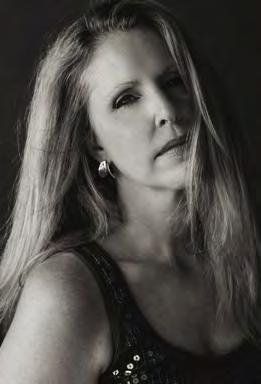
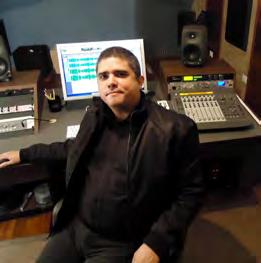
1 JUSTO MORAO ’96 of Caracas, Venezuela, arranged and produced the album Tonada, by trumpeter Morris Northcutt. The album contains a mixture of musical rhythms from Latin and North America, combining traditional music with symphonic elements.
1993
JOHN KENDALL B.M. of Sarasota, FL, recently celebrated 20 years as a guitar and modern band and orchestra teacher at Sarasota Middle School. He also actively performs as a jazz guitarist in the Sarasota and Manatee county areas, sometimes as part of the Carlos Silva and John Kendall Guitar Duo.
1994
SCOTT ASHLEY B.M. ‘94 released a new book, How to Write Better Songs: Songwriting Secrets from Award-Winning Songwriters. It recently hit no. 1 on the Amazon Best Sellers chart for paid Kindle books in the music reference category.
PHILIPP VAN ENDERT of Düsseldorf, Germany, released the album Moon Balloon, one of his biggest projects yet. It combines jazz, classical, and film music. Van Endert’s compositions were arranged by Peter Hinderthür, and the live performance at Filmstudios Babelsberg was conducted by Jörg Achim Keller.
1996
PABLO ABLANEDO of Cambridge, MA, released his original album on vinyl, and it became digitally available in July. It features ANAT COHEN B.M. ’98 , Jenny Scheinman, Ben Monder, CHRIS CHEEK B.M. ’91, JEROME SABBAGH ’98 , DIEGO URCO-

1 OSCAR PEÑAS B.M. ’99 of New York City released his fifth album, Almadraba, in February. It features Ron Carter, Harlem Quartet, Marta Sánchez, Pablo Aslan, and Richie Barshaym. Jason Olaine produced the album, and Ashley Khan wrote the liner notes. Visit oscarpenas.com.

1 SOREN SORENSEN B.M. ’98 of Cranston, RI, is an award-winning documentary filmmaker. His recent short film, With Dad, chronicles the work of Massachusetts photographer Stephen DiRado during his father’s 20-year decline and eventual death from Alzheimer’s disease. The film is available at wgbh.org/program/with-dad/with-dad.
LA ’90, FRANCO PINNA ’00, and professors FERNANDO HUERGO and DANIEL IAN SMITH.
STEVE GARBADE B.M. of Sunland-Tujunga, CA, won his second Emmy Award (Pacific Southwest Chapter) in the Musical Composition/Arrangement
category for his score for the broadcast of the 7th Annual San Diego Film Awards.
SIMONE WADDELL released her fifth studio album, The Art of Collaboration, which features some of the biggest names in Australian jazz and pays homage to
How Kelly Buchanan healed from a brain injury and regained a musical identity she thought she’d lost. BY
BRYAN PARYS
Earlier this year, singer, songwriter, and music teacher KELLY BUCHANAN
B.M. ’02 and her band released their first album. But for Buchanan, this milestone is anything but a beginning.
Buchanan spent the years after graduating from Berklee in 2002 building up a fanbase for her riot grrrl–inspired rock music in New York City, releasing her debut album, and developing a network, one that included Adam Schlesinger (Fountains of Wayne), with whom she would often cowrite songs. By 2008, her second solo album was finished; it had a release date, and hundreds of mailers were stamped. But
before its actual release, she incurred a traumatic brain injury while playing street hockey that left her unable to speak or walk. In addition to not knowing how long her career would be on a hold, Buchanan grappled with bigger existential questions.
“I lost the ability to sing and play music, everything. It felt like losing a sense of identity,” Buchanan says. “I feel like, to a certain extent, we all define ourselves by the things we do. When you are unable to actually do any of those things, you’re like, ‘How do I get a sense of self and who I am?’”
Instead of reaching others through her

music, others reached out to her: She received hundreds of cards wishing her well, and donations to help with the long road to recovery. Over the next decade, she worked constantly on healing.
“I kept pushing through it because there is no other choice,” she says. “It was either get up every day and do physical therapy and work really hard—or just give up. I choose to survive.”
For many of those recovery years, her main concern was survival; thinking about her relationship to music had to wait. “So, I can’t write a song [but] I also couldn’t walk in my house by myself and make myself dinner,” she says. “Who cares about being able to sing or play guitar?”
And yet, this year, Buchanan and her new band, the Dimestore Dolls, released their debut album, Wooly Mamas, which the group promoted with a string of tour stops, landing the album in the top 20 on college radio charts.
But the road back to her musical identity began years before Wooly Mamas came out. In 2012, she started teaching private music lessons, and later she founded MusiCorps, a nonprofit organization in Lancaster, Pennsylvania, that offers full scholarships to students who otherwise can’t afford lessons.
The words “full recovery” almost don’t do justice to her journey of healing and rediscovering music. For instance, she can sing a full octave higher than she could before her accident, and she says that her guitar playing has improved dramatically. “When I was able to start doing music again, it was amazing, and tons of songs poured out,” she says.
Beyond her sheer will to recover, she found her way back to music through fans, fellow musicians, and her students. Teaching, she says, made her think of the way that children learn by playing. “It’s a way that people have always learned, I imagine. I’m not a historian, but before we were writing stuff, we were singing songs and telling stories. And songs would be ways to remember things.”
Singing, for Buchanan, is an indispensable tool for healing, and she uses it in her teaching as much as in her own music. So, while a song such as “The River Obey,” from the new album, is about heartbreak, it’s hard not to hear echoes of Buchanan’s resilience in it. “I say blow my life down,” she sings on the track. “I’ll sing a song as it goes.”

five iconic Australian hits: “Beds Are Burning,” “Burn for You,” “Fall at Your Feet,” “The Horses,” and “Mystify.” It also includes Waddell’s own original music.
1997
DAMON HOPE B.M. of San Francisco, CA, currently leads his band the Nomad Band and owns a drum rental and teaching studio called Nomad Drum Studios. Visit nomaddrumstudios.com and nomadband.org.
1998
ZACARÍAS MARTÍNEZ DE LA RIVA ANTIGAS B.M. of Alcobendas, Spain, just finished composing an animation feature called Tad the Lost Explorer and the Emerald Tablet, and he composed for a Google commercial. He is currently working on the music for a series for Disney+ called La Chica Invisible.
2000
JOHN J. CAMPBELL B.M. of Murrieta, CA, has been the front-of-house engineer and post-produc-
tion mixer for the Hour of Power TV show for 11 years. A recent graduate from Arizona State University with a B.S. in software engineering, he is the journeyman sound technician for the IBEW 569 union.
HADDON KIME B.M. of Edinburgh, Scotland, wrote the original musical comedy LAG: A Zoomsical, which will be among the digital offerings at the 2022 Edinburgh Festival Fringe. The piece is the first original musical to be written for, and performed completely over, videoconferencing software.
2001
ANDRE DEL AMO B.M. of Etna, PA, released four instrumental guitar records accompanied by videos on YouTube under the name the Mother Tiger.
2004
EREN GÜMRÜKÇÜOĞLU B.M. of Durham, NC, accepted a tenure-track position at the Florida State University College of Music
as assistant professor of composition. Gümrükçüoğlu is also in the process of making a new album with music for instruments and electronics.
MARCO PACASSONI B.M. of Fano, Italy, released his new trio album, LIFE, with ANTONIO SANCHEZ ’97 (drums) and faculty member JOHN PATITUCCI (bass). Additionally, to promote the 100th anniversary of the vibraphone, Pacassoni did a European tour with Horacio “El Negro” Hernández.
2008
COURTNEY ELIZABETH B.M. of Ventura, CA, portrayed Mrs. Dolan in Jordan Peele’s movie Nope.
MAXIMO FLINT-MORGAN B.M. of Tully, NY, joined the staff of Le Moyne College in Syracuse, NY. He and his team provide aid for 3,000 undergraduate students and nearly 1,000 graduate students.
SARAH M. WILLIAMS B.M. of Jackson, NJ, is the managing coordinator for Mingus Dynasty, Mingus Orchestra, and the Grammy-winning Mingus Big Band. She is also director of the Charles Mingus Institute and was responsible for programming the Charles Mingus Centennial Celebrations in 2022.
ISTVAN CSEH of Érd, Hungary, orchestrated the Szeklers anthem for its 100-year anniversary. The anthem was performed by the Hungarian National Philharmonic Orchestra in Budapest.
2010
VICTOR KENNEDY of Maribor, Slovenia, is a professor of English and American studies at the
MONNIKUE MARIE MCCALL B.M. of Boston is the executive director of Harvard’s Charles Warren Center for Studies in American History and the director of administration and operations of the American Studies Program. She is also the founder of McCall Leadership, an executive coaching firm.

1 ANGEL JACINTO VELEZ ’12 of Oxnard, CA, is a music director and concert producer who is directing the live concert performance of the HBO film For Love or Country: The Arturo Sandoval Story. Velez also served as music director for Miss World 2021 and as guest conductor for the Puerto Rico Symphony Orchestra.
University of Maribor. He is the author of Strange Brew: Metaphors of Magic and Science in Rock Music (2013) as well as several articles about literature and music. He is also the co-editor of several books.
MICHELLE ZALABAK B.M. of Sherman Oaks, CA, completed her M.B.A. with an emphasis in finance and entrepreneurship. In school, she was inducted into an international honors society and was the chief financial officer for the graduate student body. She is currently interning for a private equity firm.
LOUIS DE MIEULLE of Paris, France, relocated from the United States to France and was artistically reborn as Louison. His first fully electronic prog album, Magnetic Feel, synthesizes his European classical upbringing with shameless American exuberance.
LUIZ AUGUSTO BUFF DE SOUZA E
SILVA B.M. of Valencia, CA, was recently hired as the senior director of music business and legal affairs at NBCUniversal.
ADA PASTERNAK B.M. won first prize in the Best Female Artist category at the 18th Annual International Acoustic Music Awards (IAMA) for her original

1 MICHAELA ROSE KASER B.M. ’11 of Los Angeles, who is known as Miki Rose, released a single with El Train, “Be My Lover.” TMRW magazine calls her “one of the British nu soul revolution’s most interesting young artists.” She has over 100,000 TikTok followers and over 5 million streams. Visit mikirosemusic.com.
song “Grow Older.”
2014
ALEXANDER BABOIAN B.M. of Belmont, MA, is pursuing his master’s degree in the Jazz Department of the Royal Conservatoire Antwerp in Belgium. Baboian recently performed a program of Chris Potter’s tunes with the Antwerp Jazz Orchestra and Bert Joris that was arranged by Baboian and students in the ensemble.
ANTOINE FATOUT of Dublin, OH, opened his music school, Fa2 Drum Studio, in Columbus, OH, in 2014. His first album, Trio Fa2, was released this year and features Stan Smith and Roger Hines.
INDIA THOMSON B.M. of St. Petersburg, FL, was promoted to assistant vice president at Citi Private Bank Law Firm Group. She received her Series 31 securities license, which entitles her to sell managed futures funds or supervise those activities.
2016
CHELCIE GETTE B.M. of Brentwood, TN, is a pop and soul artist who released her first album in August.
ELIZABETH TURNER B.M., M.M. of Miami Lakes, FL, received her Doctor of Education (Ed.D.) in
leadership and innovation from St. Thomas University in Miami, Florida, where she is serving as the director of choir and musical theater.
2017
TANCREDI LO CIGNO of Florence, Italy, is a drummer and teacher whose video course on rhythmic illusions, Time Trip, was published by Hudson Music. It was published as an ebook in 2020, making Lo Cigno the first Italian author on Hudson Music’s roster. Visit hudsonmusic.com/product/ time-trip.
SETH D. MILLS B.M. of Englewood, NJ, founded Topaz Music Consulting, a music consulting business dedicated to protect-
ing digital rights of independent music.
NYCHELLE WINTERS B.M. of Duncanville, TX, is an Irma P. Hall Black Theater Award–winning actress who has performed in many off-Broadway productions. After becoming a certified music teacher, she now serves as the general music and choir director for grades K–8 at Harry Stone Montessori Academy in Dallas.
2018
MATIAS BAHAMONDES ’18 of Santiago, Chile, is a member of the death-metal band Overtoun and won the 2022 Pulsar Award in the Best Metal Artist category for his work on the band’s new album, This Darkness Feels Alive,
5 TRACY YANG ’15 of Elmhurst, NY, winner of the Charlie Parker Jazz Composition Prize and Manny Albam Commission in 2021, premiered her commissioned piece “Sea Swell” at Dizzy’s Club in New York City. Yang is also a recipient of a 2022 NYC Women’s Fund for Media, Music, and Theatre grant.
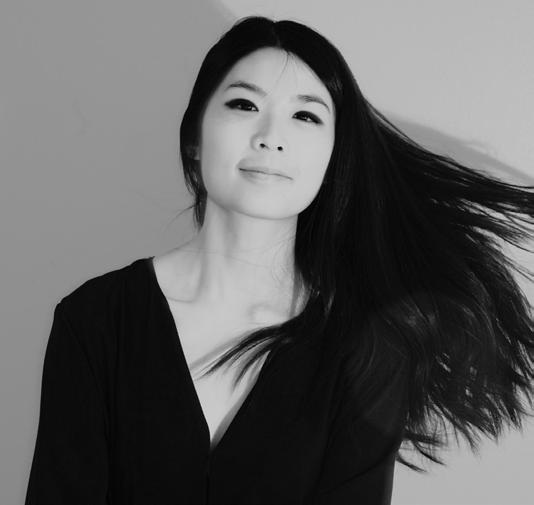
SCOTT KARATH ’80 of Centerville, MA, died of a heart attack on February 22, 2019. He was 61. Karath had mentored many young musicians and gave them playing and studio experience as they moved forward in their careers. Starting in the 1980s, he had three bands: 2.3 Kids, the Ricardos, and Shindignation. At the time of his death he was working on a musical based on the movie Tough Guys Don’t Dance. He leaves his wife, Rita Karath.
JOHN PICCHIONI B.M. ’68 of Uxbridge, MA, died March 5. He was 90. Picchioni taught music at the Woonsocket Junior High School, in Woonsocket, RI, for 30 years. A Korean War veteran, he served the U.S. Army and was a member of the U.S. Army Band in Europe. He leaves his son, John V. Picchioni Jr.; sister, Vicky; and two granddaughters. He was predeceased by his wife, Shirley M. (Russell) Picchioni, and daughter, Clara Picchioni.
DEAN ROYSTON of Raymond, NH, died unexpectedly March 26. He was 33. A police officer in Berklee’s Public Safety Department for the past three years, Royston was instrumental in departmental training and was deeply involved in community engagement. He leaves his wife, Shauna H. (Murphy) Royston; daughter, Natalie; brother, Adam Royston; and grandmother.
MATTHEW HAYES B.M. ’06 of Amesbury, MA, died April 3. He was 37. A two-time Grammy-nominated engineer, Hayes had worked at several studios in the Boston area. In 2007, he became the house engineer at Wellspring Sound Recording Studio in Acton, MA, where he spent the rest of his career. In 2018, he also started working as the production manager at Scullers

Jazz Club. He leaves his wife, Samantha; two sons, Hunter and Leon; parents, Constance and John Hayes; and brother, Jeffrey Hayes.
JAY BINDER ’70 of New York City died April 15. He was 71. Binder, a New England Conservatory alumnus, was the casting director for nearly 100 Broadway productions, including Lost in Yonkers, The King and I, Chicago, The Lion King, and A Gentleman’s Guide to Love and Murder. Binder earned 11 Artios Awards from the Casting Society of America, and received Tony nominations as a producer in 1998 and 2010.
REID JORGENSEN JR. ’69 of Wellesley, MA, died April 24. He was 79. Jorgensen worked for more than 50 years at the Rivers School Conservatory in Weston, MA, instructing students in both jazz and classical styles. He also spent time as chair of its Percussion Department. In addition, he owned and managed Studio 203 in Boston from 1976 to 1991, and taught percussion at Wellesley College from 1993 to 2001. He leaves his wife, Judy; stepdaughter, Heather Wilson (Thaddeus); step-grandchildren; and many cousins.
EDWARD PALIOTTA ’79 of Las Vegas, NV, died April 29. He was 65. A realtor by profession, Palliota continued to play and write music throughout his life. He leaves his wife, Charmaine Paliotta; daughters, Tiffany and Kaylani; son, Gilbert; twin brother, John Paliotta; and granddaughters.
1 MEGHAN STABILE ’06 of Valrico, FL, died June 12. She was 39. According to her grandmother, the cause of death was suicide. Stabile was a show promoter and producer who founded Revive Music Group, a New York City company that specialized in bringing together jazz and hiphop audiences and that had an imprint on Blue Note Records. She had hoped to open a wellness center for jazz musicians, her grandmother, Maureen Freeman, told the New York Times. In addition to her grandmother, Stabile leaves her brother, Michael Skidds, and sister, Caitlyn Chaloux.
TIMOTHY E. PRICE B.M. ’73 of Exeter, PA, died July 21. He was 70. A renowned woodwind artist and jazz musician, Price played with many famous artists, wrote for Saxophone Journal, authored three books about the saxophone, and taught at the New School Univer-
sity in New York City. He leaves his wife, Marcia A. (Maslar) Price; his mother; sisters, Barbara Esparza and Susan Blue; and nieces and nephews. His sister Debra Evens predeceased him.
DEANNA KIDD-SZYMCZAK of Sagamore, MA, died August 4. She was 84. A retired professor of music education who taught at Berklee for 35 years, KiddSzymczak was the college’s first female professor. Most recently, she was a Berklee student teacher observer. Kidd-Szymczak had earned her master’s degree in music education from the Boston Conservatory. She leaves behind her husband, Michael Thomas Szymczak; siblings, Sharon DeSisto, Stephen Dustin, and Randall Dustin, and many nieces and nephews.
FAITH LUETH of Walpole, MA, died August 12. She was 79. Lueth was a professor of music education at Berklee and the conductor of the Women’s Choir at Gordon College. She held a master’s degree in choral conducting from Boston Conservatory. She leaves her husband, Richard A. Lueth II; daughter, Rachel Lueth Carroll; and a granddaughter.
LES HARRIS SR. of Newburyport, MA, died September 10. He was 90. Harris studied at Berklee and was a faculty member for 28 years, teaching arranging, harmony, ear training, and listening analysis, and he ran tutorial services. “He became my mentor, colleague, [and] great friend... He was a gentle giant in all aspects of his life,” says Danny Harrington, professor emeritus. Harris was also a drummer with several bands. He leaves his wife, Janet Harris; son, Les Harris Jr.; daughters, Cynthia Schulz, Debbie Wood, and Melissa Moore; and five grandchildren.
produced by Pancho Arenas and mastered by the legendary Metallica producer Flemming Rasmussen.
GABRIELLE LIRIANO B.M. of Montvale, NJ, completed a commission for Apollo5, a chamber choir of the VOCES8 Foundation, based in the United Kingdom. Apollo5 will be performing the piece as well as recording it for its new album. Liriano will also be featured in Choir & Organ magazine.
2019
ALIYA CYCON B.M., M.M. and her band, the Aliya Cycon Project, performed as the central event in a community festival this June in Valencia, Spain, that sought to raise awareness of refugees. The festival was organized in recognition of World Refugee Day.

1 DOROTHEA MARCHELL JACKSON
‘22 of New York City is a jazz performer and songwriter, and a private instructor at the New York Jazz Academy. Her new album, Strong Black Women, was released in July, and she performed at the Jazz Museum of Harlem. Visit bit.ly/3AcTy10.
2021
ELLA SOLANA GARCÍA B.M. released her first album, A Butterfly in Dappled Shade, in July. It features performances by CARLISAAC KRULEWITCH B.M. ’21, COLIN JENKINS B.M. ’19, and RHIANNON RAMSEY-BRIMBERG B.M. ’20, and can be found on YouTube and all streaming platforms.
5 PABLO MIRETE GODOY B.M. ’19 of Los Angeles composed and produced the music for the film Umbrellas, which is nominated for a Goya Award, and for which he received the Fugaz Award for Best Original Score. Godoy also produces for several artists around the world.

(CONTINUED FROM P. 64)
try’s revolution to be solid and something that constitutes a legacy for future generations, we must demand that artists and composers raise their level of writing. We must ensure that the stories, emotions, metaphors, and experiences that our songs in Spanish tell are worthy of inclusion in an exquisite repertoire that represents some of the greatest artists in history. It’s extremely important for new generations to learn from artists such as Rubén Blades, Jorge Drexler, and JUAN LUIS GUERRA ’82 ’09H in order to write exceptional songs with great texts, melodies, and harmonies.
Berklee is a leader in the effort to secure this legacy. Ever since the college awarded flamenco artist Paco de Lucía an honorary doctorate more than a decade ago, we at Berklee’s Mediterranean Music Institute have been creating a series of classes that focus on improving the quality of work by young artists and composers of music in Spanish who will soon lead the Latin music industry. Specifically, the class Songwriting in Spanish teaches skills that are fundamental for young musicians, future Latin Grammy winners, and those who currently collaborate with industry greats such as ALEJANDRO SANZ ’13H or C. Tangana and contribute material of the highest quality. Young Latino graduates of Berklee can feel proud that our institution has equipped them with all the necessary tools to be able to write good songs in Spanish, with great texts and unforgettable melodies.
Increased knowledge of all the wonderful musical traditions of Latin America, combined with the potential for this music to reach a mainstream audience, ensures that the evolution music in Spanish is going through, particularly in the United States, will not be temporary. It will endure, helping to build a foundation that guarantees the place of the Spanish-speaking community in the most important music industry in the world.

JAVIER LIMÓN
ARTISTIC DIRECTOR, MEDITERRANEAN MUSIC INSTITUTE
In a world in which digitization and globalization are bringing us all closer together, we are probably on the verge of organizing our society in new ways. Until now, our cultural groups have been defined by the countries we feel a part of. Today, it is different languages that, through the internet, unite or separate us.
The six most widely spoken languages in the world are English, Mandarin Chinese, Hindi, Spanish, French, and Arabic. All the people who speak Arabic, for example, consider themselves part of the same cultural world—one in which music and the arts play a crucial role. The same holds true for the Spanish-speaking world. But something historic is happening with the Spanish language, in particular, that will probably change the course of the music industry for decades.
There is nothing that travels better than music, there is no content more highly digitized than music, and there is no industry with a better future in our digital world than the music business. In particular, music in Spanish has grown extraordinarily in recent years. In the United States, there aren’t
Grammys for French or Chinese music, only for English and Spanish music, and that is for one reason: the impact that Latin culture has had in the U.S.
In a few years, the United States will be one of the countries with the highest number of Spanish speakers. According to projections by the United States Census Bureau, in 30 years the number of people in the U.S. who are of Hispanic origin will be over 111 million, or 27.5 percent of the country’s population. These numbers are corroborated by Harvard’s Instituto Cervantes, which Berklee has worked with since the institute’s founding 10 years ago. This rise in Spanish speakers, along with U.S. economic strength, makes the U.S. an extraordinarily strong market for Latin music.
But not everything is perfect for the Spanish-language music industry. Most of its mainstream success is related to a type of music of low lyrical quality. It is true that the production, arrangements, and enthusiasm of music with Latin roots is extremely exotic and attractive. However, as Latin musicians and as Spanish speakers, if we really want this indus- (CONTINUED ON P. 63)
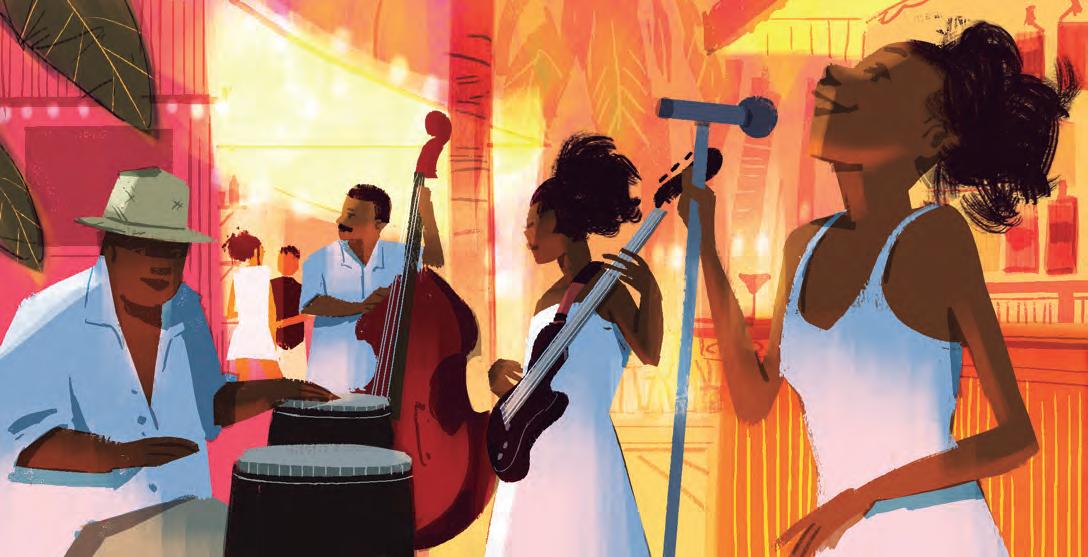

“We are so excited and honored to have won the 18th Annual IAMA First Prize for Best Group Award and the Overall Grand Prize! This truly comes at an incredible time for us. The band is just getting back on the road after a very long two years, (due to the pandemic), and we can’t wait to see the new places that this opportunity will take us to. Buffalo Rose is so grateful to be a part of the acoustic music tradition and to be able to create and experience music and joy with the world. A massive thank you to our team and all of our wonderful fans! We have so much new music coming this year and can’t wait to share it with you all!”
- Shane McLaughlin, Top winner of the 18th Annual IAMA (International Acoustic Music Awards) who plays guitar and vocals with the acoustic group Buffalo Rose.
“I have felt more connected with International Music Acoustic Awards far more than any other music award competitions or musician awards”
– Amanda Grace, singer-songwriter.
PLATINUM SPONSORS:
“I’d like to thank the IAMA for the honor of this award. It’s nice to know that there are still nice surprises around the bend on this long winding path of a career. I love a good song — writing them, hearing them by other people, and sharing them that seems to fit into the mission of IAMA. Thanks for reminding me I’m on the right track still!”
– Ellis Paul, Top winner of 16th Annual IAMA (International Acoustic Music Awards)
“I am thrilled and honored to be recognized. It’s also inspiring that my song “Put the Gun Down” that addresses such a pressing issue in a personal way, can have an impact and win this award” – Jonatha Brooke, Top winner of the 15th Annual IAMA (International Acoustic Music Awards)
“I am very excited and surprised to win” – Meghan Trainor, 6th Annual IAMA Best Female Artist Winner.


SPONSORS:









“Because we come from the Maya, more than anything, we need to respect this type of music. It’s our origin.”
SEE PAGE 20